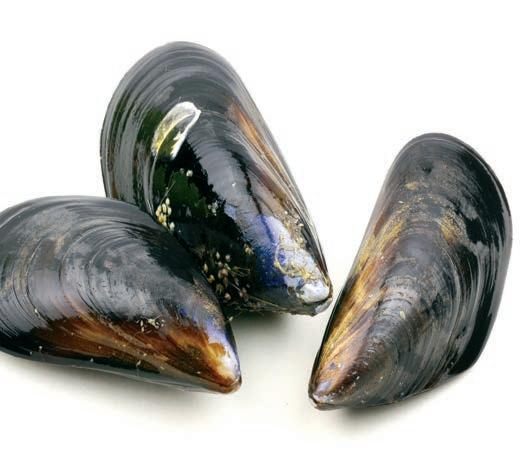





















The last couple of years have not been easy ones for the Estonian fisheries and aquaculture sector. Just as the government lifted restrictions brought in on account of the pandemic, and travel and trade resumed, war broke out in Ukraine unleashing a new set of challenges. Sales of fish to Ukraine, a key export destination, were affected negatively early in the conflict for a few weeks. More lasting has been the impact on energy prices. Costs for fuel for vessels, gas, and electricity have shot up affecting fishing and fish farming companies as well as processors. The government is helping with an initial package of measures for SMEs and now a further measure for larger companies. These initiatives are intended to mitigate the increase in fuel prices for vessels and in electricity prices for processors and fish farmers. Higher energy prices also contribute to inflation, which in turn forces companies to rethink their investment plans. Some projects are likely to be delayed as a result. Estonia’s programme for the European Maritime, Fisheries, and Aquaculture Fund (EMFAF) was recently approved. It aims to make the sector more sustainable, help it fight climate change, and preserve biodiversity among other objectives. Aquaculture is due to get a boost that should see production increase several-fold by 2025. Read more from page 14
Biodegradeable fishing gear may contribute to reducing the volume of plastic that accumulates in the sea, a huge problem that is still growing. The fishing and aquaculture industry, according to a WWF study, is responsible for a tenth of marine waste globally. Not only do fishing nets discarded at sea remain in the water for years, but during that time they damage habitats and kill marine wild life. There are many good arguments to switch to biodegradeable plastic. Made from biofibres that originate from potato or sugar cane, they break down in 2-3 years rather than the 500-600 years it takes for conventional plastics to degrade. They do not contain the harmful chemical compounds seen in plastic, their carbon footprint is smaller, and their use would help to achieve two or three of the UN’s sustainable development goals. On the other hand, biodegradeable nets are currently not as tough, durable, cheap, or reliable as regular plastic nets. In the EU, policies are aimed at reducing pollution with plastic nets by making it easier to recycle them and efforts to retrieve those lost at sea are being increased. In addition, several projects are testing biodegradeable nets with the aim of improving them to the point where they can compete with conventional plastic. Read Dr Manfred Klinkhardt’s article on page 36

In Poland too the fisheries and aquaculture sector can feel the effects of Russia’s aggression in Ukraine. As in Estonia, exports to the east shrank, energy prices spiked, and Poland offered shelter to huge numbers of Ukrainians fleeing the war. The Polish fishing sector has made infrastructure such as fish boxes and coldstores available to Ukrainian fishers leading to a increased prices for these services in Poland. Wage costs have increased as Ukrainians employed in Polish processing or fishing companies returned home to defend their country. Replacing these employees has been expensive. The inland fisheries and aquaculture sectors noted a marked increase in the price of materials, notably fuel and feed, and in inputs such as oxygen. In the processing sector disruptions took the form of reduced demand from certain markets, and also supply chain interruptions making it more difficult and more expensive to get hold of key raw materials including salmon, mackerel, trout, and sprat. The Polish government is making use of EU funds to reduce the impact of market disturbances by compensating companies for additional costs they incur. Read more on page 45
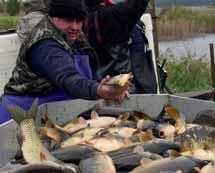
Rapa whelk, a marine snail, has invaded the Black Sea from its home range in the Indian Ocean and the Sea of Japan. Thanks to its high fertility as well as its tolerance for a variety of salinities, temperatures, oxygen levels, and pollution intensities, the animal has been highly successful at colonising the areas it invades. In the Black Sea it has established itself so thoroughly that it has become a resource that is caught, processed, and exported by companies in Bulgaria, Romania, and Turkey to destinations in east Asia. The snail is prized not only for its meat but also for its decorative shell and it is hunted by artisanal fishers in Turkey and in Bulgaria. Rapa whelks are highly predatory feeding on shellfish including mussels, oysters, scallops, cockles, and clams, as well as on carrion such as dead fish or crabs. It has few predators of its own, mainly starfish and blue crabs (in the Chesapeake Bay). The snails proliferate at a very high rate—older animals can produce up to a million eggs four times a year, a number that allows the animal to spread rapidly despite the high mortality of the larvae. Read more about this invasive species from page 56



13 Sustainable fisheries in the Mediterranean and the Black Sea come a step closer
GFCM celebrates its 70th anniversary












14 Estonian fisheries and aquaculture State support partly offsets cost increases
18 Sustainably exploiting Estonian resources of the algae Furcellaria lumbricalis
Strong environmental focus resonates with customers

21 A thesis seeks to improve coastal environments and offer an alternate income source
Inventing uses for mussels too small to eat
24 Owner of Peipsi lake processing company welcomes change in fishing system
Greater transparency will benefit the fishery
27 M.V. Wool processes fish for international and Estonian consumers
Increased input costs start to bite
30 Good catches of coldwater prawn help offset the rise in fuel costs
Decent prices contribute too
32 The Center of Food and Fermentation Technologies has created an international reputation
Research and development for the food sector
34 Power Algae designs equipment and protocols to cultivate microalgae
Optimising strategies to produce at scale
36 New ideas to reduce ghost nets in the sea
Fishing gear made from biodegradable plastic
40 A brief overview of maritime spatial planning (MSP) in Europe

MSP can help solve conflicts between maritime activities

42 Russian fishing sector faces shortage of new trawlers as sanctions bite
Lack of new vessels could impact future catches

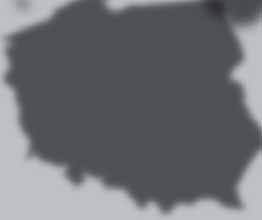









45 The impact of the war in Ukraine on the Polish fisheries and aquaculture sector Costs increase across the board
48 Turkish delegation travels to France to study shellfish cultivation
A new farming activity calls for thorough groundwork
50 Mussels sold under the protected designation of origin label Amphibious vehicles greatly facilitate harvesting
52 Planting bouchot further offshore will allow mussels to grow larger New farming techniques are not always popular
54 Online meetings and working from home not conducive to oyster consumption Covid brings lasting change to the French oyster market
56 Rapana – the predatory and highly invasive marine snail An uninvited guest in the Black Sea and elsewhere
59 Replacing plastic is currently very difficult Fish packaging is becoming a high-tech product
Guest Pages: Jarek Zielinski,

62 The head of the Baltic Sea Advisory Council executive committee has his work cut out Mitigating the socioeconomic impacts of declining fishing opportunities
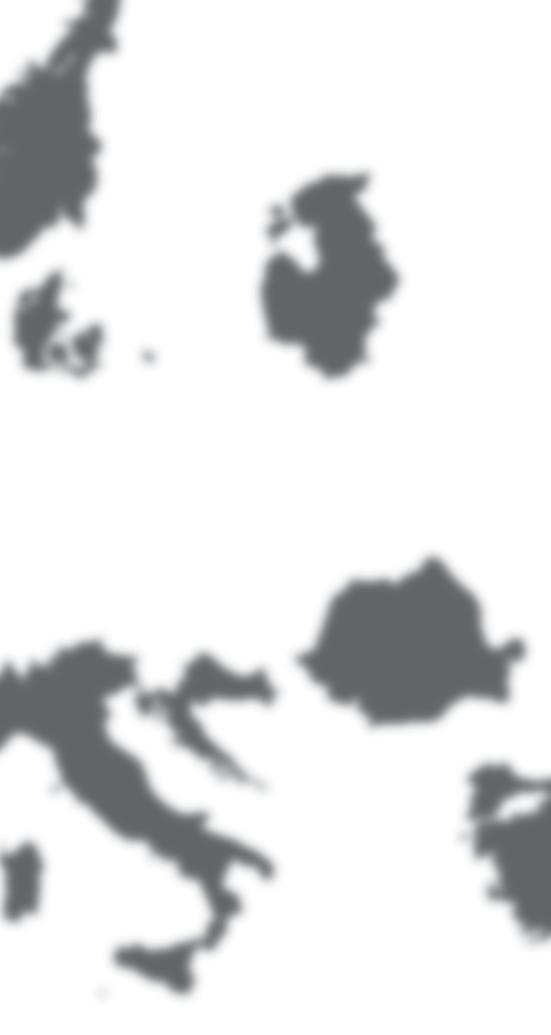
Service
65 Diary Dates

66 Imprint, List of Advertisers



















A plan determining renewed short-term access for EU fishing boats for important fish stocks shared between the EU and the UK was approved by the EU Council in late December, the Commission announced. The deal on “fishing opportunities” sets total allowable catches (TACs) for EU and UK fishermen, separately, for 2023, and for certain deep-sea stocks for 2023-2024.
In the North Atlantic and North Sea, the exclusive economic zone (EEZ) of the EU abuts that of the UK, creating a boundary that

fishing boats normally cannot cross but that fish populations normally can and do. Managing these fish stocks therefore requires bilateral EU-UK cooperation in the setting of TACs and other management tools.
The plan recently announced is required by the 2020 EU-UK Trade and Cooperation Agreement, a result of the Brexit negotiations. With respect to bilaterally shared fishery resources, the Trade and Cooperation Agreement provides for annual modifications of the joint
management of shared fisheries by the EU and the UK, in particular annual changes in TACs. The annual fisheries plan must take into account:
• international obligations
• the recommended maximum sustainable yield (MSY) for each species, to ensure the long-term sustainability of fishing in line with the common fisheries policy
• the best available scientific advice, with a precautionary approach taken where such advice is not available
• the need to protect the livelihoods of fishermen and women.
as the English Channel, the Irish Sea, and the North Sea. For example, there are separate TACs for haddock in the Irish Sea and those in the waters of Portugal, and separate TACs for herring in the Eastern English Channel and those in the Irish Sea.
Jousting over the EU-UK fisheries deal is not yet over: during the “adjustment period” until 30 June 2026 part of the EU quota share will be transferred to the UK. After 1 July 2026 EU-UK access to waters and fishing opportunities will be negotiated annually.
The annual plan negotiations normally also include Norway and the Faroes to avoid a separate agreement between those countries and the EU and one with the UK on much of the same fish stocks, and for the first time the latest negotiations were joined by Greenland and Iceland for the same reason. About 100 species are included in the access agreement, ranging from Norway lobster and other shellfish to cod and other demersal species, to mackerel and other pelagic species. Following ICES advice, TACs are traditionally set for each species in each of several geographic areas, such
Aside from the controversial but real question about Member States adequately enforcing the TACs, the agreement is a step forward, according to the EU Council. The deal helps protect the health of both the fishing industry and the fish stocks. If the continued downturn in the latter is not arrested, the former will continue to suffer too. Many TACs in the new agreement represent reductions in previous years’ TACs, which in principle will allow some severely stressed fish stocks to recover. Overall, the EU-UK deal provides EU fishers with over 300,000 tonnes of fish and shellfish “fishing opportunities,” in the words of the Council. UK fishermen have access to 140,000 tonnes of fish, which the UK Fisheries Minister claimed makes UK fishermen “30,000 tonnes better off now that we are outside the EU than we would’ve been if we’d remained as a member state,” referring to an estimated total UK TAC for 2023 had the UK remained in the EU.
The fifth Baltic Sea Fisheries Forum will take place in Tallinn, Estonia on 12 April 2023. This year’s event will take place at the T1 Mall of Tallinn, and it is also possible to participate remotely. The forum will focus on managing fleets to achieve the objectives of the Common Fisheries Policy.
According to the European Union’s Common Fisheries Policy, the purpose of adjusting fleet capacity to fishing opportunities is to achieve economically viable fleets. At the same time, to ensure that fishing activities are environmentally sustainable in the long term,
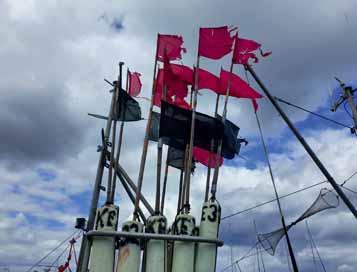
total allowable catches (TAC) are set based on maximum sustainable yield (MSY). Given this, is the management of fishing fleets then necessary? Fisheries experts from different countries will share their experience with modern fisheries management system and try to answer to this
question. EU policy makers, scientists and representatives from the fisheries sector are welcome to participate in the forum. More information will shortly be available on the Baltic Sea Fisheries Forum website (https://worksup. com/app?id=balticfi shery2023), so save the date!
Recognising the need for a single registry of the national fishing fleet, the Spanish government’s Council of Ministers recently approved a royal decree regulating, for the first time, the structure of the General Registry of the Fishing Fleet. Until now, autonomous communities shared with the national Ministry of Agriculture, Fisheries and Food the rights and responsibilities concerning vessel registration, leading to inefficiency. An effective single registry of vessels is a key element in fisheries management.
Each EU nation’s fishing capacity is regulated by the EU Common
Fishery Policy, and nations must ensure their own fishing capacity conforms to the rules. Fishing vessel replacement -- and entry of new vessels -- must match CFP obligations. The new royal decree makes it easier to ensure Spain’s fleet is properly managed. In recent years, some concerns have emerged that make fleet management more challenging, including environmental impacts of fishing and energy efficiency of vessels. By consolidating vessel management into one regulatory process the government intends that the royal decree will help managers and the industry alike.



Sea clam producers in Italy’s Veneto region welcomed a recent confirmation by the EU that clams from Italian waters are subject to a minimum size of 22 mm in contrast to the 25 mm limit in Spain and elsewhere in the EU. The difference is due to the nature of the ecosystem in the waters of Veneto and other Italian regions, which affects the growth of sea clams there. Opposing the EU decision was Spain, who argued that the disparity in the legal clam size puts Spanish producers at a competitive disadvantage vis-àvis their Italian rivals. In assessing the relation between clam size and ecosystem characteristics, the EU put weight on the question of sustainability of the species and the ecosystem. The minimum clam size rules are aimed at sustainability, not market characteristics or competitive forces, and they are intended to make sure a species is not harvested when reproductively immature, regardless of shell size or market value.
The new regulatory framework combines existing management tools with new ones, making the former more flexible. Such a combination will help the Spanish fishing fleet adapt to the modern requirements of the sector.
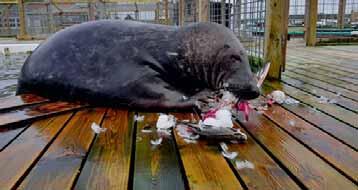
When two groups of predators compete for the same food supply, one group can benefit by reducing the size of the other. For the fish off Estonia’s coast, harvested by both grey seals (Halichoerus grypus) and fishermen, this is exactly the proposed plan: a cull of the seal herds. Seals not only eat fish that swim free, but more detrimental to fishermen, they also eat fish in fishermen’s nets, damaging gear in the process. Seals also often take just a bite out of a fish, and the injury to the fish can cause parasite infection, threatening other fish within a population. Baltic fisheries are already in peril, according to ICES, with stocks of cod and other important species continuing their long-run decline. The grey seal population, on the other hand, is thriving, with an estimated growth rate of 5-6 annually and a Baltic population
of about 30,000 animals. Within Estonian waters, researchers counted a 20-year high of 6,000 grey seals in the most recent aerial survey, according to the fisheries department of Estonia’s Ministry of Environment.
An annual quota for grey seal hunting is already in place in Estonia, set at one percent of population size, or currently 55 animals. But because the quota is not currently being met (the quota has been 25-50 filled in recent years), simply increasing the quota would be ineffective. A managed cull, perhaps with incentives, might produce more results. The possible opinion of the seals with respect to the proposed idea is expressed by many, including an expert on seal biology who argues that seals are blamed too quickly for the gear damage. More study of
the fishing industry is urged, to possibly identify problems in the industry itself instead of blaming seals, cormorants, and other wildlife that feed on fish in fixed nets.
Other opponents of a simple cull include experts sympathetic
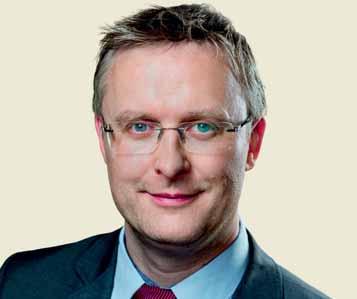
A member of Parliament from Denmark’s Venstre, the second largest party in the coalition, has been appointed the new Minister of Food, Agriculture and Fisheries, Prime Minister Mette Frederiksen (Social Democrats) has announced. Jacob Jensen, 49, has been an MP since 2005, representing Zealand, including Copenhagen, and was the parliamentary spokesman on environment from 2017 until his ministerial appointment, his first ministerial job. Prior to election to Parliament, Mr Jensen worked in various capacities for the A.P. MøllerMaersk container logistics company from 1998-2007; he obtained an MSc degree in business administration and mercantile law from Copenhagen Business School in 1998.
As Minister of Food, Agriculture and Fisheries, Mr Jensen oversees the Danish Agricultural Agency, the Fisheries Agency, and the Veterinary and Food Administration. The Ministry previously (2015-2020) included the Environment Agency, which was split off as a separate ministry (as it was prior to 2015). The Fisheries Agency supports and regulates commercial and recreational fishing in Denmark. It promotes Denmark’s green transition, in part using resources from the European Fisheries Fund, working to develop sustainable fisheries and aquaculture and associated maritime activities. Mr Jensen faces a disgruntled commercial fishing sector, who have had to endure ever-tightening fishing quotas in the North and Baltic Seas, and
Fisheries
loss of access to British waters in the North Sea following Brexit. Other issues affecting fishermen,
to the fishermen’s plight. One suggestion is a cull limited to immediate areas of fishermen’s nets, because it is believed that a minority of the seals are responsible for the gear damage -- “the smart ones,” in the words of an expert, i.e., the ones who know where the easy fish are.
including fuel prices and the North Sea II pipeline, are outside his ministry’s purview.


The EU imports 65 of the seafood it consumes, a dependency that raises EU vulnerability to cost increases such as that caused by the transport disruption during the pandemic, an expert told attendees at a EUMOFA webinar recently. Mark Turenhaut of the Dutch Fish Federation said that the high import share of finished product and raw material exposes EU fish processors, downstream distributors, and consumers to price increases in seafood itself, and in transport such as ocean freight and fuel. These costs may not be caused by the industry but there are solutions within the industry in concert with national and EU governments.
For example, the management of fishing quotas can be improved. Quotas are necessary and are set based on scientific advice, but they are not always efficiently
managed. Some quotas are not completely filled, meaning EU-produced fish is less than it could be. Another example is aquaculture, where greater support by government, including investment incentives, would increase EU fish and shellfish production. Mr Turenhaut also recommended the development of alternative products from fishery and aquaculture, not only to grow more revenue per fish but also to spread that revenue across multiple product lines, to reduce total dependency on any one product market. Another action at EU policy level would be to expand trade agreements that provide tariff reductions on imports from developing countries, making imported raw material—and the products EU processors produce from them— cheaper, passing the lower costs on to consumers.
Boosting EU production of fishery and aquaculture products to shrink imports’ share of EU supply would contribute to the seafood sector’s ability to withstand import
supply fluctuations and volatile costs of transport logistics and of other inputs that are often global in nature, and not easily addressed by individual companies.

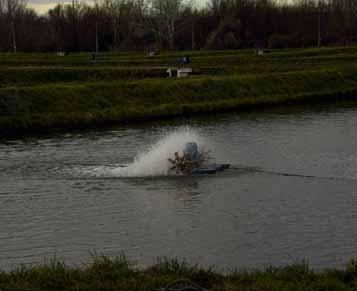
For the fishery and aquaculture industry of Hungary, times have been tough recently. Ponds and rivers are in the midst of the worst drought in a century; production costs of fuel and feed, like elsewhere in Europe, are at record levels; markets are yet to fully recover from the pandemic, and the Russian war against Ukraine is disrupting the industry in many ways.
December saw the organization of the general assembly of the Hungarian Aquaculture and Fisheries Inter-Branch Organization (MA-HAL), at which the industry was urged to carry on, even though 2022 saw some companies’ balance sheets turning red. New technologies are needed,
as well as improved marketing systems for value-added growth, and tighter enforcement of rules against excessive and illegal fishing and other activities. Technology and innovation support is forthcoming from the Hungarian University of Agricultural and Life Sciences, assembly attendees were informed. At government level, the recent adoption by the EU of the Hungarian Fish Farming Operational Programme Plus, covering the period 2021-2027, will provide needed support and development of the aquaculture sector. Over two thirds of that programme’s funding that comes from the EU is part of a larger package of EU funds for Hungary that is still being negotiated.

There is positive news for 2023 for large segments of the world’s aquaculture industry, including shrimp, salmon, tilapia, and pangasius. Experts from Netherlands-based Rabobank presented their predictions for 2023 at the Global Seafood Alliance’s recent GOAL Conference 2022 in Seattle, including estimates of output trends in major producing countries and demand or market conditions in large consuming parts of the world. Their presentation at the GOAL Conference was based on a report from Rabobank’s RaboResearch branch, “What to Expect in the Aquaculture Industry in 2023,” available at https://research.rabobank.com/ far/en/sectors/animal-protein/ what-to-expect-in-the-aquaculture-industry-in-2023.html.
Tropical shrimp looks to be a big winner, especially in Ecuador
where production in 2023 may grow by 30 in volume, an increase of 300,000 tonnes, on par with Thailand’s total annual production. Total Latin American output is expected to exceed 2 million tonnes. Total production in Asia, the world’s leading region led by China, saw a slight decline in 2022 but is expected to bounce back in 2023, with output exceeding 4 million tonnes. Overall, global shrimp supply is projected to grow by 4.2. “Normalise” is a market analysis codeword for “calm down”, and after a few volatile years, salmon producers in Norway and Chile will “normalise” salmon production in 2023 to historically lower growth rates, because markets need steady rather than fluctuating supplies. Thus, Norwegian output, which grew by 12 in 2021 before falling by 0.9 in
2022, will grow by 3.5 in 2023, closer to the long-run average growth rate. Chilean output fell by 8 in 2021 and 0.3 in 2022, but could grow by 2.5 in 2023, which again is closer to long-run trends.
Other important aquaculture species in global trade, including tilapia—with the highest production growth rates now seen in Latin America rather than Asia—and pangasius—still dominated by Asia— are also covered by the report.
In most of Europe, the value added tax (VAT) on seafood is considerably lower than the average applied to consumer goods generally. The tax is zero in the UK and in EU member states Ireland and Malta. Elsewhere in the EU, the VAT on seafood in France, Germany, Hungary, and Portugal ranges from 5 to 6. In Spain, however, seafood is subject to the 10 VAT applied generally to non-basic foods. Besides being a basic food, the most emphasised reason that much of Europe gives seafood a lower VAT is, it’s an especially healthy protein. On the other hand, almost everywhere -- including Spain -- the taxes on fuel used by fishermen have been cut to help them deal with the economic turmoil running through Europe in recent years. This has helped the industry weather the effects of the
pandemic, Brexit, and Russia’s invasion of Ukraine, among other international disasters.
Seafood consumers should get a financial break like the fishing industry does, says the Spanish Fisheries Confederation (CEPESCA). Household consumption of seafood in Spain has fallen by 25 in the last 14 years, the organisation reports, and a seafood tax that is double the average is a significant reason why. CEPESCA criticised the government for neglecting to lower VAT on seafood because the excessive tax drives consumers away from the healthy part of any balanced diet. The group noted seafood’s quality and nutritional properties, which give it a prominent place in the socalled Mediterranean and Atlantic “diets” that health experts around the world encourage. CEPESCA’s
The standard VAT rate in Spain is 21%, while the reduced rate of 10% is applied to all non-basic food. A super-reduced rate of 4% is applied to basic foods: bread, milk, eggs, cheese, fruit and vegetables, and cereals. Seafood is not considered a basic food.
calculations indicate that reducing the VAT on seafood would cost Spain’s treasury less than EUR 500 million, which the group indicated
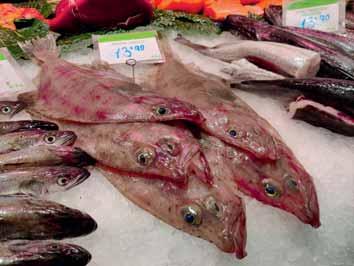
might be completely offset by reduced government expenditures for citizens’ health problems caused by unwholesome diets.
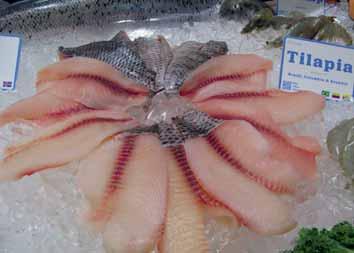





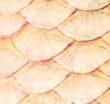











Danish industry, from global shipping to reusable coffee cups, is known internationally for leadership in “green” or sustainable technology and practices. This innovative mindset has been given an added boost in the seafood industry with an outlay from the European Maritime, Fisheries, and Aquaculture Fund (EMFAF) “to achieve green transition, support sustainable and energy efficient fisheries and aquaculture, as well as to enhance marine biodiversity in Denmark.”
The programme, extending through 2027, is funded with EUR 287 million in contributions from the EU (70) and the Danish Government (30). Some 86 of this funding is allocated for sustainable fisheries and the conservation of aquatic resources: inducements for energy efficiency of fishing vessels through research and innovation and investments; investments to comply with the landing obligation; promotion and marketing; support to improve data collection and control and enforcement; and funding for river
restoration. Another 8 is channelled to sustainable aquaculture: including innovation, research, and investments in sustainable aquaculture to reduce negative ecosystem impacts and enhance energy efficiency; promotion and marketing. The remaining 6 is intended for technical assistance.
Denmark hopes to become a role model in the EU’s green transition with, among other things, a stated target of 70 reduction in CO2 emissions by 2030. Its EMFAF programme aims at improving gear selectivity for more efficient and sustainable fishing, and energy efficiency in both fisheries and aquaculture to reduce costs as well as ecosystem impacts. Measures that support the digital transition in fisheries and aquaculture are intended to improve economic efficiency and also environmental sustainability, with better fisheries management (e.g., setting, meeting, and enforcing quotas) and production and marketing of seafood from both fisheries and aquaculture.

Albania is home to Lake Shkodër, the largest freshwater body on the Balkan peninsula. On Albania’s northwest border with Montenegro and seasonally varying between 370 and 530 sq. km, the lake has historically been filled to the brim with carp. But in more recent years this important fishery resource has dwindled in size, suffering the same challenges faced in countless freshwater and marine areas: shoreside development and climate change, exacerbated by excessive and illegal fishing practices. Over time, the resource’s decline has driven people elsewhere in search of livelihoods.
Help is at hand, thanks to an FAO initiative begun in 2022 and aimed at restoring Albania’s inland fish resources through development of much-needed sustainable fishing practices, supplemented by aquaculture to rebuild breeding stocks. The initiative is part of
FAO’s AdriaMed Project, which is funded by the Italian Ministry of Agriculture, Food and Forestry Policies. Working with the countries along the Adriatic and Mediterranean, AdriaMed promotes scientific and institutional cooperation to improve the regional management of the fishing and aquaculture sectors. In this case, FAO is partnering with Albania’s Ministry of Agriculture and Rural Development. The project brings young people into contact with older fishermen and women, to be inspired and to “learn their ways.” FAO staff use this approach with older fishers to keep their traditions alive and to use them to support sustainable practices that will create industry opportunities for jobs, environmental protection, and support for livelihoods in the long-term.
A vital part of the Lake Shkodër project has been the establishment of an aquaculture
programme to replace the lake’s dwindling hatchery capacity. Carp broodstock were collected for breeding and transferred to enclosures for induced spawning. When the eggs hatch the larvae are raised to young fish, big enough to ensure a good rate of survival. These fish were released
into the lake for the first time in June 2022. Roland Kristo, Deputy Minister of Albania’s Ministry of Agriculture and Rural Development, who is in charge of fisheries and aquaculture, says the project has already delivered results and that the lake’s fisheries now have a future.
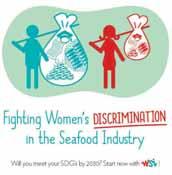
Throughout history and across the globe, leadership positions in the seafood industry, from vessel captains to corporate CEOs, have been dominated by men. Around the world, fish and shellfish processing plants mostly employ women on the factory floor but men in the management. In North America and Europe, women who captain their own fishing boat are famous (some have Youtube channels) solely because there are so few of them. All the world’s women who chair an international seafood corporation could hold a meeting in a small boardroom.
In the last several years women have gained enhanced recognition
and gender acceptance in this “masculine” industry, and one body to thank for this is the International Organization for Women in the Seafood Industry. WSI was founded in 2016 by a group of gender and seafood experts as a feminist organization to join the battle for gender equality and women’s empowerment in the seafood sector. “Over the past six years, WSI has been an influential international feminist organization and recognized as a first-class source of reliable scientific information on gender issues in many publications, fora and events,” as described on WSI’s website.
However, increasing financial constraints have put pressure on

WSI, and in a statement issued in December its board announced that WSI is reluctantly ceasing operations. “The decision was made with much regret and following long deliberations,” WSI’s board said in a news release. “However, the spirit of the work remains. Hence, WSI is hopeful that other organizations, companies, and institutions – working in fisheries and aquaculture, human and social rights, feminism, and gender equality – will start or continue to build on WSI’s legacy to keep the fight for a seafood industry free of gender inequalities, free of sexism and gender-based discriminations, where everybody enjoys equal opportunities and working conditions.”
Women account for almost half the workforce in the seafood industry; however, less than 15% of them hold high and well-paid positions. WSI has shown the way and now other individuals and institutions must step up as the move towards greater equality between genders must continue for the sake of future generations.
Sustainable fisheries in the Mediterranean and the Black Sea come a step closer
The 45th session of the General Fisheries Commission for the Mediterranean (GFCM) of the Food and Agriculture Organization of the United Nations (FAO) was held in Tirana, Albania, from 7 to 11 November 2022 and was attended by delegates from 22 contracting parties, 2 cooperating non-contracting parties, 2 non-contracting parties, representatives of 13 intergovernmental organisations, non-governmental organizations, FAO, and the GFCM Secretariat.
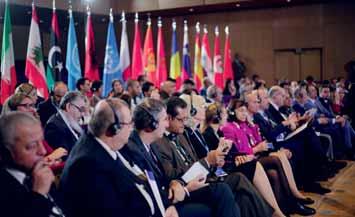
The 45th session also celebrated the 70th anniversary of the GFCM. Ms Frida Krifca, the Albanian Minister for Agriculture and Rural Development, and Dr Manuel Barange, Director of the FAO Fisheries and Aquaculture Division, opened the event presenting the evolution of the GFCM into its current form as a modern regional fisheries management organization. Their speeches acknowledged the role of FAO, under whose auspices GFCM was founded and managed.
During the session contracting parties including the European Union adopted a series of binding recommendations and resolutions addressing reinforcement of a research programme on rapa whelk, measures for the management of European eel, red coral, blackspot seabream, giant red shrimp, blue and red shrimp and turbot, as well as catch limits, temporal or spatial closures, and restrictions on recreational fisheries. Of 21 measures, 19 were presented by the European Union—for the management and control of fisheries, aquaculture, and the protection of sensitive habitats in the Mediterranean and Black Sea. The EU also supports the implementation of measures and the new ‘GFCM 2030’ strategy with an annual grant of EUR 8 million. For the first time ever, countries have fixed general rules regulating
transhipments at sea in the Mediterranean and the Black Sea, entailing a complete prohibition except in cases of force majeure
Furthermore, upon the successful completion of a pilot phase, management measures to curtail Illegal, unreported, and unregulated (IUU) fishing were reinforced with long-term permanent inspection schemes valid until 2030. The schemes encourage joint efforts among countries to organize inspections and surveillance, provide means and human capacity, and harmonise practices and procedures. Finally, the GFCM logbook established in 2010 was updated with new requirements in line with recent GFCM objectives and priorities. Fishers now play a more essential role in providing information reported in vessel logbooks on the bycatch of vulnerable species (seabirds, sea turtles, marine mammals, Chondrichthyans, sponges, and corals) during fishing operations. Moreover, more than 1,000 non-indigenous species have been identified in the Mediterranean and the Black Sea. Over half of these fish, jellyfish, prawns, and other marine species have established permanent populations and are spreading, threatening marine ecosystems and local fishing communities. GFCM members agreed to launch a pilot study in the eastern Mediterranean that is considered a hotspot for non-indigenous species, towards developing a model to be exported to the rest of the region.
A Mediterranean-wide observatory will be created in Turkey.
Based on a proposal made by Egypt, the session adopted
a resolution on empowering women in the aquaculture sector aiming to encourage CPCs (cooperating non-contracting party) to develop national and sectoral strategies and policies to support the empowerment of women in the aquaculture sector.
After a selection process overseen by the FAO management and GFCM members, the FAO Director-General proposed Dr Miguel Bernal as the new GFCM Executive Secretary. The nomination of the Spanish national was unanimously approved by the GFCM Members this week. As Executive Secretary, Miguel Bernal will be responsible during five years, for the implementation of the policies and activities of the GFCM. On behalf of GFCM contracting parties, he will manage the Secretariat, administer the GFCM autonomous budget, ensure coordination with relevant FAO Divisions and Units, promote the role of the GFCM in relevant fora, secure extra-budgetary funds, and maintain formal relationships with contracting parties, partners, and other stakeholders.
The 45th session of the GFCM adopted several measures that should make fisheries in the Mediterranean and the Black Sea more sustainable.The Estonian fisheries sector has returned to business following the pandemic apparently without facing any serious long-term effects. E-commerce, which flourished during covid, is likely to continue in one form or another as consumers have accustomed themselves to the convenience of buying fish online. Export markets, the main focus of Estonia’s sprat and Baltic herring producers, largely remained open after initially closing borders at the beginning of the pandemic. Fish shops, restaurants, catering establishments, and hotels function without restrictions so, in general, ways of doing business within th e fisheries sector have not changed.
As the market recovered from the covid crisis, the war broke out in Ukraine. For Estonian processors of sprat and herring this was another emergency following on the heels of the first. Ukraine is the most important market for Estonian suppliers of these pelagic fish and immediately after the onset of hostilities all shipments stopped. Belarus, a transit destination for supplies to Ukraine, was targeted by sanctions and was no longer accessible. Shipments to Ukraine through Poland were put on hold as both exporters and importers waited to see how the situation would develop. Siim Tiidemann, Deputy Secretary General for Fisheries Policy and Foreign Affairs in the Ministry of Rural Affairs, adds that some Ukrainian fish shops closed and buyers of Estonian fish delayed settling their bills due to the situation.
However, by the middle of April 2022, some five weeks after the war began, exports of sprat and herring picked up again, says Eduard Koitmaa from the Ministry of Rural Affairs after

studying the data from Estonian Tax and Customs Board. Ukraine is a big country and the aggression focused on certain areas. Estonian processors and traders and their Ukrainian counterparts found ways to resume the movement of sprat and Baltic herring into those parts of the country that were less affected by the war. In fact, the trade was better than it was during the covid years and therefore the ministry did not have to enact measures to support the industry. Logistics were an issue, however. The border crossing between Poland and Ukraine was used not just for the transport of fish but also other goods, including humanitarian aid, resulting initially in queues and delays due to the sheer volume of goods that was crossing the border. According to Mr Koitmaa, another contributory factor was the switch from EU trucks to Ukrainian trucks that was made at the border to meet insurance requirements. But even under difficult conditions people continue to eat so demand picked up again and factories continued to work. In March the Ukrainian hryvnia had not yet depreciated to the extent that it did a few months later, so imports were still affordable.
Of the three fishing producer organisations in Estonia, one sends almost its entire production to Ukraine and while it has also started looking for new markets it still supplies Ukraine as despite the war the country is open. The three POs, which catch some 95 of Estonia’s sprat and Baltic herring quota, have found ways to operate in
these new circumstances, says Kairi Šljaiteris from the Ministry of Rural Affairs, but they have also had to adapt. For example, a marketing campaign prepared between the Estonian Fisheries Information Centre and the Estonian Association of Fisheries to promote fish under the label “Baltic Premium Fish” in Ukraine has now been shelved.
The product imported from Estonia is block frozen Baltic herring and sprat that is then made into products for human consumption in Ukrainian factories. Another popular item is spiced sprat. The analysis of the data from the Estonian Tax and Customs Board also revealed canned fish products being exported from Estonia for humanitarian purposes and dried sprat and Baltic herring being sold in the UK for petfood.
Another fallout from the Ukraine war is the rise in energy prices. While the high gas prices have affected the processing industry to an extent it is the high cost of electricity that causes the real suffering. Some companies have benefited from fixed price contracts with long durations that they signed before the war, but others have seen their costs rise as electricity prices increase. The ministry is in the process of
approving a new measure that will offer support to companies hit by higher electricity prices. Ms Šljaiteris says that several national measures have already been approved and are bringing relief to small and medium companies, but the measure currently being processed by the ministry is funded under the EMFF (European Maritime and Fisheries Fund 2014-2020) and will support companies retrospectively. The compensation comes from money in the fund earmarked for extraordinary
measures as the EMFF period is closing at the end of 2023. Disbursal of the aid is likely to start in February 2023. The support targets the Baltic Sea trawling fleet and the long-distance fleet which are the two segments that use the most fuel. The support scheme compares the average price of fuel over a period before the war with the average price after the war started and offers the difference as compensation. Consumption of fuel by the coastal fleet is relatively modest and setting up a system of compensation for the small volumes of fuel used by individual coastal fishers would be too onerous. Coastal fishers benefit therefore only from national schemes that reduce taxes on fuel. The second part of the scheme supports companies that experienced steep increases in their electricity bills. Here again electricity costs before and after the onset of the war are compared and companies are entitled to the difference in the form of support for the period March to December 2022. This aid flows mostly to processing and fish farming companies.
Companies also invested in diversifying their energy supplies, for example, by establishing solar parks. The EMFF
offered support for this activity, but interest from the sector was only modest. Now, with electricity and gas prices rising significantly, there has been a surge of interest in greener options from businesses in the sector, says Mr Koitmaa. In addition, during the covid crisis getting hold of solar panels was difficult and companies were more wary about investing due to the unstable situation.
The Estonian programme for the European Maritime, Fisheries, and Aquaculture Fund 2021-2027 (EMFAF) was recently approved by the European Commission. The EU contribution amounts to EUR 97m and the national contribution to EUR 42m. Virginijus Sinkevi ius, Commissioner for Environment, Oceans and Fisheries noted that the programme would focus on stimulating research, innovation, and investments in energy efficiency. The biggest chunk of the allocation (38) goes towards sustainable aquaculture and processing, while sustainable fisheries receives a third, and blue economy activities, which include the
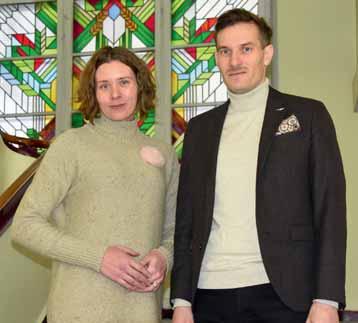
implementation of communityled local development (CLLD) strategies, receive 22. The goals of the programme are to boost the sector’s resilience by making it more sustainable, to fight climate change, to preserve biodiversity, and to combat marine litter among other targets. The new programme will continue from the old (2014-2020) which also had a heavy focus on the environment in relation to fisheries, aquaculture, and local community development, says Mr Tiidemann. Among the bigger changes he mentions is the way scientific projects within fisheries are dealt with. Estonia has decided to create three different research programmes where the issues to be studied are defined by the ministry in discussion with scientists and the fisheries sector. This way resources can be directed towards projects, more environmentally friendly fishing, for example, to ensure that the outcomes will be useful for fishermen. Another area of focus is the aquaculture sector, production from which like European production as a whole, has tended to stagnate. We want our aquaculture to move more towards the sea, he says, because costs in land-based aquaculture are relatively high and output has not shown any significant increase. The goal now is to increase production to 10,000 tonnes by 2025 (from 850 tonnes
in 2021). Mr Tiidemann admits this is an ambitious target but points out that there are several project applications to produce fish in the sea. The environmental impact of farming fish in the Baltic Sea and ways to compensate for these effects, for example by growing mussels or algae, will necessarily be taken into account when evaluating projects. A further plan is to pre-grow the fish on land to a certain size to create a market for juvenile fish which can then be introduced into cages in the sea. This reflects a change from the last programme period when investments in new farms were not funded but existing farms could apply for support. He is aware that for any operator costs will have to be kept down as competition from Norwegian salmon and trout will be fierce.
Today, with the highest inflation in the euro zone, Estonian producers are struggling with ballooning costs. To some extent these can be passed on to consumers, but they too are switching to cheaper alternatives. However, most of the production is exported and the export figures have remained strong suggesting that buyers abroad are absorbing the increased prices. Mr Tiidemann points to the other impact of inflation which is that companies are deferring their investments because prices have increased so much. Even plans that have been approved for support from the EMFF are being put on hold for this reason. Additional support to compensate for increased prices in not available,
according to fund rules, he says. Groundfish such as cod have not been targeted by Estonian fishers for the last several years so they have not been affected by the slashed cod quotas in the Baltic Sea. Decommissioning of vessels is not encouraged by the administration as the removed capacity is difficult to reinstate when stocks recover. Instead, Mr Tiidemann would rather put money into measures that help the stocks such as habitat regeneration, or establishing spawning and nursery areas. This is in line with the goals of the CFP and also more in tune with Mr Tiidemann’s personal convictions.
The lack of interest in a fishing career among young people is another ingredient in a complex situation of struggling stocks, excess fishing capacity, and ageing fishermen. A young fisher has to make substantial investments in a vessel, equipment, and fishing rights before he can start fishing. In addition, the job is physically highly demanding and there are lots of rules to
follow. These factors contribute to young people’s preference for careers in other industries. The administration is trying to encourage fishers to add more value to their catch and sell it locally through direct sales to consumers rather than to middlemen. This will give the fishers a greater share of the value and increase the local consumption of fish as well as contribute to the economy of coastal communities. If young people see how money can be made through fishing and further processing they may also be more inclined to join the trade. At the same time the administration has to balance the need to encourage young people to join the trade with the excess capacity that exists already.
In recent years some European countries have carried out tests with remote electronic monitoring which refers to a system of cameras on board fishing vessels which monitor the fishing operations. Many fishers are against the idea of being watched as they work, so trials have offered incentives (such as a bigger catch quota). The idea is to discourage discarding or other illegal activities while fishing. In Estonia the administration places more value
on educating the fishermen to abide by the legislation. The measures in place should be sufficient to prevent such activities. If cameras are to be deployed it should be based on risk assessment and the results should be analysed to establish whether such tools influence fisher behaviour. In the pelagic trawling fleet which is responsible for the bulk of the Estonian catch discards are hardly an issue. That said Estonia has an ongoing trial where three Baltic trawlers targeting sprat and herring have been equipped with cameras. Another measure to monitor fisheries is the introduction of an app PERK through which fishers register their catches. Use of the app is voluntary at the moment but will be obligatory from 2024 and it will be particularly useful to monitor the activity of fishermen on the Peipsi lake where individual transferable quotas have just replaced the previous “Olympic” method. Under the latter system fishers catch their quotas as fast as
possible and then stop fishing. To ensure the app is used, the ministry also offers support to fishers to purchase a suitable mobile phone in case they do not have one and has organized training sessions to use the app.
The impact of climate change on water temperature has not been a serious issue for several consecutive years in Estonia but that may be changing. Summer temperatures were higher than normal in 2018 to 2020 and precipitation was lower, according to the meteorological office. This trend if it persists is likely to have an impact on the aquaculture sector. Some adaptation measures are planned, for example, investments in oxygenating systems and deep wells which should help in dry periods, and the positioning of cages in deeper water in the
Baltic, so that the fish can avoid warmer surface water. With support from the EMFF and EMFAF companies are also reducing their contributions to greenhouse gas emissions by investing in new energy-saving equipment, and by setting up solar panels to produce energy for their own use. Under the EMFAF 2021-2027 programme fishermen can invest in new engines for their vessels if they emit 15 less carbon dioxide than the old engines. Fishers are happy with the fund and the opportunities it offers, says Mr Tiidemann, though there are a couple of things they would like to change including the high administrative burden and the proportion of the allocation that goes to local action groups as well as into administration either as technical aid or for fisheries control and data collection. Some grumble about the need for energy audits which are necessary to unlock support for energy- and resource-saving equipment, for example. But in general, there have been no major differences in opinion about the support and how it is used, and fishers appreciate that it covers some of the increased costs they face due to the war.
The Estonian fisheries and aquaculture sector has shown its ability to cope with crises of different kinds. Support from the EMFAF to make the industry more environmentally and economically sustainable will further increase its resilience to shocks, so that it is less affected and quicker to recover when faced with headwinds in the future.

Algae cultivation forms part of the EU vision for a more sustainable and competitive aquaculture sector. The production of algae is also highlighted in the EU’s farm to fork strategy, a blueprint for a healthy and environmentally friendly food system . The reasons for the official interest in algae are manifold. In a broader context, population growth, climate change, resource depletion and environmental factors call for a new approach to food systems.
One of the ways to address these pressures is to use Earth’s seas and oceans more to produce human food. These vast resources only contribute 2 to human food despite covering 70 of the globe. More immediately, the Russian aggression in Ukraine has affected supplies of fertiliser, animal feed ingredients, and energy. Algae, both macroand microalgae, can contribute to mitigating some of these shortages and also offer several other benefits including decarbonisation, the preservation and restoration of biodiversity, protection of ecosystems. Algae can be used as food, fuel, feed, and fertiliser and serve as a raw material for biostimulants, biochemicals, and other materials including packaging.
With their content of micronutrients, bioactive compounds, dietary fibre, and pigments algae have applications in the field of pharmaceuticals, nutraceuticals, cosmetics. They can also remove nutrients (nitrogen and phosphorus) from aquatic ecosystems. Macroalgae (seaweed) when cultivated at sea removes carbon thereby mitigating ocean acidification. Despite the benefits that algae offer, production in Europe is virtually non-existent being still based on harvesting
from the wild rather than farming. In Asia, by contrast, algae accounts for about half the production from aquaculture. However, the potential for algae production in the EU is high—the bloc is already major imported of seaweed and demand is forecast to increase in the future in line with increased focus on health and sustainability. In Estonia the company Est-Agar is exploiting the growing demand for algae products. The company produces furcellaran, a gelling agent, from the red seaweed Furcellaria lumbricalis. As a gelling agent and texturiser furcellaran is used in the food industry, but it also has a number of other applications in cosmetics, pharmaceuticals, feed for animals and fish, fertiliser and soil conditioners as well as bioplastic applications.
The company has been through different economic and political times, as it was established in 1966 under the Soviet regime but has functioned uninterrupted from its inception. Today it is privately owned by four seaweed enthusiasts. Co-owners Urmas Pau and Mart Mere, act as the CEO and business development officer respectively. The Soviet Union could not import agar agar, a commonly used gelling agent also derived from seaweed, and needed therefore to produce it domestically. Three factories were established each in
Latvia, the Russian Far East, and Estonia, of which the plant in Estonia is the only one remaining. The factory was built specifically to exploit Furcellaria lumbricalis and is today, according to Mr Mere, the only factory in the world producing furcellaran, a product that can only be extracted from this variety of seaweed. Currently, rather than growing it, the company harvests the seaweed from the wild. For this it is licensed by the government which allows it a quota in the Baltic Sea. The estimated biomass present in Estonian waters is over 200,000 tonnes wet weight mostly between the Estonian islands. The resource is managed by the Estonian Marine Institute and the company’s quota is 2,000 tonnes, it may be possible
to increase the quota over time, but the goal is to start farming the seaweed, says Mr Mere.
Trials have been carried out over the last five years and the technique has now been tested in the sea. In addition, Estonia’s marine spatial planning strategy was recently approved which identifies sites for different farming activities, bringing commercial farming of seaweed by the company a step closer to fruition. The factory is located on the island of Saaremaa, the biggest
Estonian island. The building is the one built nearly 60 years ago and even some of the equipment, custom built in Estonia, dates back to that time. The current owners of the company bought the factory from the previous owners six years ago and have since then invested considerable sums in modernising it, including making it more environmentally friendly. One of the measures was to use switch from oil to LNG as a source of heat, but as prices shot up it was substituted with LPG. The factory can now run on four sources of energy including biogas. The waste water treatment process was also upgraded both to increase efficiency, but also to send a message to the company’s customers, the food industry,
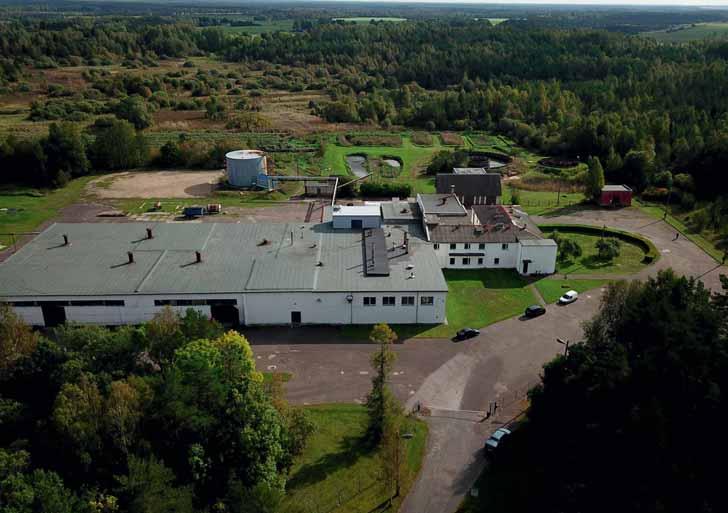
cosmetics, and some pharmaceutical companies, that it takes its environmental obligations seriously. This is also reflected in the solar panels that have been installed on the roof of the building and which, in summer, cover about a third of the company’s consumption of electricity.
The image that Est-Agar wants to convey of an environmentally conscious company partly explains why it wants to start farming. It is another reason why the proper management of the wild seaweed biomass is so important. Part of the material the company uses is the biomass that drifts ashore when there is a storm. Some 20 families from the local community are contracted
by the company to gather the seaweed from the beach after a storm and dry it. The final product is then sold to the company. This arrangement goes back many years—it is the second or third generation of these families that is carrying out this work today. While initially the work was done manually some families have now invested in tractors and other equipment making it a commercial undertaking. This integration into the community and the support that it can offer local workers is an important aspect of the business for the company. However, the material collected this way is not enough to sustain the company’s operations, but just to supplement the biomass from harvesting. The frequency and
intensity of storms vary greatly and the biomass available for collection can be 30 tonnes one year and 300 tonnes the next. But usually whatever volume the families supply, the company buys it all.
Extracting the furcellaran is done by adding freshwater from a well to the seaweed and then boiling it, a process that demands a lot of heat. Some of the machinery runs on steam which the company generates itself. And, as far as possible, the heat is recycled and used to warm the factory. Another environmental measure is the collection of rainwater to
wash the seaweed. Resource efficiency has been baked into the upgrades and the investments that that have been made to reassure buyers that the environmental footprint of the product is as small as possible. The company has now started a process that will assess each operation for its carbon production to get a granular picture of overall emissions so that it can implement measures to reduce them further.
Kärla Village Saare County 93501 Estonia
Tel. +372 454 2205 info@estagar.ee estagar.ee
Owners: Urmas Pau CEO; Mart Mere, BDO; UG Investments
The fact that furcellaran is a plant-based food ingredient is a very useful attribute as this market is rapidly increasing. The cosmetic industry, in particular, is focused on using plant-based materials and when it originates in the sea this is even better. Seaweeds, in general, have several useful components and F. lumbricalis is no exception. For now, Est-Agar is looking at extracting pigments and antioxidants The plan is to use a multi-extraction process that allows different components to be extracted one after the other. While the technique has shown promising results in the laboratory, it needs to be tested at scale. Another idea is to create a product from the material left over from the boiling process. This could be formed into small pots that can be used to grow salads or herbs. The residual furcellaran content would allow the material to act as a membrane that controls the water content of the pot.
The company already exports over four fifths of its production to 10 countries. The product takes two forms—furcellaran flakes and powder but going forward more of the powder will be produced as it is easier to mix with other products. Powder is the future, says Mr Mere.
Product: Furcellaran (a gelling agent and texturiser from the seaweed Furcellaria lumbricalis)

Production: Up to 150 tonnes per year
Applications: Food, cosmetics, and pharmaceutical industries
Volume of raw material: 2,000 tonnes of seaweed harvested from the wild

Mussel farming in the Baltic Sea could potentially help to counteract eutrophication while at the same time providing economic opportunities for small and medium enterprises using mussels as food, feed, and fertiliser.
Exploring the potential of mussel as feed is an academic with an unusual background. Indrek Adler is earning his Ph.D at the Estonian Maritime Academy, a part of the Tallinn University of Technology. His interest is potential applications for mussels as feed or in the pharmaceutical, cosmetic, or nutraceutical industries.
He comes to his doctorate with a degree in business studies and a working life spent on the commercial side of different companies. But he wears a second hat too, that of a coastal fisherman, an identity he has carried for many years having fished recreationally since he was a child. He represents the fourth generation of fishers in his family, his grandfather was in fact a full-time professional fisherman, and for his father too it was almost an occupation. Today, Mr Adler lives on the Pärispea peninsula, the northernmost tip of Estonia, where he has ready access to the sea and can indulge his hobby whenever possible.
Fishing even for sport has over the years showed Mr Adler how the stock status of the species he targets has been changing. Catches fluctuate from year to year with some species in abundance one year and absent the next, new
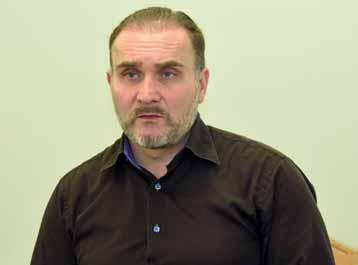
species enter the area and gradually take over, but the overall trend has been one of decline. So, three or four years ago Mr Adler began to wonder how he could contribute to improving the situation for the benefit of fishers and the wider coastal community. He recognised that catches were not big enough for a fisher to make a living and part of the reason for this development was pollution in the water. Solving the pollution problem would contribute to rebuilding the fisheries so that coastal fishers could once again expect to catch enough fish to support themselves. Researching possible ways to improve the coastal environment, Mr Adler came across aquaculture but noted that it too tended to add to pollution levels unless it related to the production of macroalgae or mussels.
However, the low salinity levels in the Eastern Baltic meant there were not many species that thrive in this environment. Further research showed that the blue mussel (Mytilus edulis/M. trossulus) was about the only species that would be feasible. Mr Adler then joined the masters programme at the Estonian University of Life Sciences with a view to gaining a better understanding of the issues and to identifying a possible solution.
Eutrophication in the Baltic Sea
is widespread; Helcom assesses over 97 of the sea to suffer from eutrophication due to past and current inputs of excess levels of the nutrients, nitrogen and phosphorus. The nutrients boost the production of algae, cyanobacteria, and benthic macro vegetation leading to greater turbidity and increased creation of organic material that in turn depletes oxygen levels at the sea bed as it decomposes. Nutrient inflows from land have decreased significantly over the last decades, but the effects of this decline have not yet manifested themselves. A more recent source of nutrients is the aquaculture industry where uneaten feed and faecal matter contribute to eutrophication locally as well as in a wider area as the particles spread.
However, addressing the problem by farming seaweed or mussels is still a challenge, partly because low salinity hinders the rapid growth of the biomass, but also because there is no regulatory framework in place that will enable the allocation of space in the sea for this activity. More importantly, though, farming mussels is not economically viable because the biomass produced has no value. It could be used as fertiliser on fields, but that has little or no added value. It cannot be used for human consumption because the mussels in the Gulf of Finland are too small due to the low salinity. Extracting the meat is very expensive because of the small size of the mussels. It can be done with, for example, enzymes, but that
pushes the price up. So, there are few uses to which the biomass can be put unless a valuable and easily extractible ingredient can be identified in the mussel. Mr Adler’s research at the masters level focused on finding suitable techniques to extract the meat from the shell simply and economically. This area had not really been explored before as countries where mussels are grown in the Baltic Sea do not use the biomass as food for human consumption.
He developed a method in which the mussels were first ground

in a meat processor to create a paste. When mixed with water the particles of shell in the paste sink faster to the bottom than the meat. The meat and water can thus be decanted while most of the shell will stay back. For a small or medium enterprise this would be an economically viable way of separating the shell from the meat. The end products at this stage of the experiment are the crushed shell, and the meat and water mixture. The crushed shell also contains a certain level of protein and Mr Adler thinks it could be used as poultry feed either on its own or as an ingredient. It offers calcium, nutrition in the form of protein, and the grit that birds need to digest their feed. The water is another
potentially useful product as some studies have shown that it contains a compound that could, for example, prevent the oxidation of cut fruit (the discolouring that occurs when the cut piece is exposed to air). This may be useful to the retail sector as the water is organic and has no side effects. However, the water has a certain off taste. To remove it Mr Adler is experimenting with the addition of citric acid to the mixture of mussels and water. The really interesting end product, however, is the meat which, after centrifugation and drying, appears as a powder with a very high (65-70) content of protein. It can potentially be used as a standalone product or more likely as an ingredient in
other products to increase their protein content. This powder is intended for human consumption as it will earn a higher price than if it were used for animal or bird feed.
The experiments have also resulted in several other interesting observations. One is that the harvest season influences the yield from the mussels and the colour of the final protein powder. Powder samples from the spring and fall batches of the mussels have now been sent for chemical analysis to investigate the reasons for these differences. That there should be a difference is not surprising as in the spring the mussels are coming out of the winter season, they have not
been feeding, while in the fall they are well fed, the water is a bit warmer, and this could lead to differences in the chemical composition. In addition, the spring harvest has a much higher proportion of barnacles in the biomass compared with the autumn
harvest. Currently Mr Adler removes the barnacles (manually) as they do not add any nutritional value to the final product. The yield of protein powder from a batch of spring mussels is 5-8, while an autumn batch delivers better than 8.
The overall goal of the experiments is to identify readily scalable ways of producing useful products from the mussel biomass. This means that fancy or expensive ingredients or techniques are ruled out. The off-taste issue is an example of a challenge that can be addressed in different ways, but for Mr Adler the solution needs to be industrially scalable. The protein powder can be marketed as a sustainable product as it is produced without harming the environment. On

the contrary, the raw material (the mussels) from which it is derived has a beneficial impact on the environment. Even the ropes to grow the mussels will be made of coconut fibre to ensure the sustainability of the operation, while buoys and anchors will also be made of environmentally friendly material. If everything works out as planned farming mussels could be a way for communities to cheaply improve their coastal environment and at the same time earn something from it—which was the outcome Mr Adler hoped to achieve when he embarked on this journey.
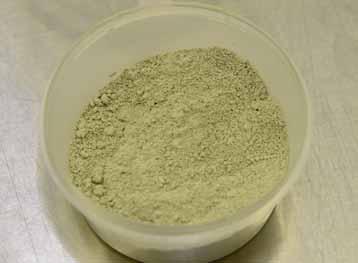
Estonia has an inland water fishery concentrated on the lakes Võrtsjärv, Peipsi and Lämmijärv. The latter two lakes are connected to each other and form a transboundary water body shared with Russia. The total inland fisheries catch in 2021 was 2,700 tonnes, the vast majority of which comes from Peipsi and Lämmijärv. The main species caught in Peipsi and Lämmijärv are pikeperch, perch and bream together with smaller volumes of roach, while in Võrtsjärv the catch is primarily bream, pikeperch, and pike as well as eel.
The gear used are trap nets (mainly bream, eel, and pike) and gill nets (mainly pikeperch). In Peipsi and Lämmijärv the main gear used are also gill nets and trap nets of different kinds. Danish seines and pound nets are also used mainly for perch and vendace respectively.
On Võrtsjärv the number of fishing permits issued over the decade ending 2020 increased 43 to 63. In contrast, the number of fishers on Peipsi and Lämmijärv fell by over 40 over the same period from 406 to 238.
Processing companies on Lake Peipsi are organised into a producer organisation (PO), Peipsi Kalandusühistu. The PO is headed by Margus Narusing, who also owns the company OÜ Latikas, a processor of freshwater fish. The company is the biggest member of the producer organisation. The PO is located at the port of Mehikoorma on Lake Peipsi where it has reception facilities for the fish landed and a cold store. The PO sells the fish caught by its members under its own brand and has opened dedicated shops in Tartu and Tallinn to sell the fish caught by its members.
The main activity of the company is to catch and process fish into fillets, and other cuts, steaks, portions, whole fish head on or head off, as well as smoked items, and delicatessen products. The waste from the processing operation, heads, guts, tails, fins, backbones, etc., are frozen and transported to Latvia, where it is used to feed animals bred for their fur, such as mink. The main species targeted are bream, perch, pikeperch, and pike with annual volumes ranging from 150-200 tonnes of bream, 50 tonnes of perch, 30-40 tonnes of pikeperch, and 10-15 tonnes of pike. There are also small catches of burbot and roach.
Most of the fish is sold whole, fresh, but if the catches are too large or there is little demand for fresh fish then it is frozen or further processed into cuts or smoked pieces. Frozen bream, however, is the product that sells most. The catch is sold through the supermarket chain, Coop, through fresh food markets, and through the PO’s own stores. These stores do not only sell the PO’s products, but also other fish, such as Arctic charr farmed in Poland and processed at the PO’s facility, and wild-caught eel. The catching season is in spring, summer, and autumn, and during the winter catches depend on whether the lakes are frozen over or not.
But, in general, if the catches are good then all this fish is available throughout the year either fresh or frozen, Mr Narusing confirms. Most of the fish stocks are managed with quotas. But this (2023) is the first year where Mr Narusing expects the quotas to last until the end of the year. In the past they tended to be used up by September
or October. The difference is the catching regime: until 2022 fishing followed an Olympic system where fishers competed against each other catching as much as they could until the quota was filled. From 1 January 2023 this system will be replaced by individual quotas. Fishers can distribute their catches to ensure they have fresh
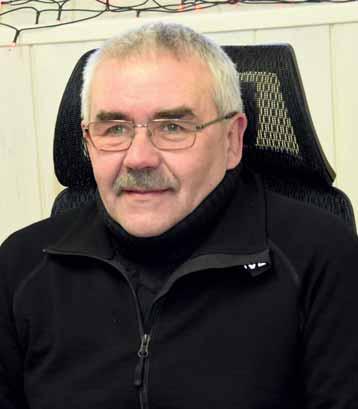
fish all the year round. Mr Narusing feels the change is positive and will result in a certain stability to the activity. The Olympic method meant that at the start of the year fishers would set out on the lake as fast as possible with all their capacity to catch as much fish as fast as possible. This resulted in the quota being filled already before the end of the year and the fish having to be frozen. The frozen product was fine if it was to be further prepared or preserved—smoked, dried, marinated etc.—but customers preferred fresh fish if they were to prepare it themselves; the frozen product tasted different.

The Olympic system divided the processor and the fishers in the
sense that processors disliked the system for the lack of stable catches and the need to freeze fish, while fishers appreciated it. Mr Narusing’s company, Latikas, both employs people to fish and signs contracts with independent fishers. Other fishers operating in the lake catch and sell fish to other companies. The change in system will mean that there is greater monitoring and control of the fishing activity which is likely to become more transparent as a result. Not all fishers consider this an advantage which is why some fishers prefer the Olympic catching system. For Latikas, apart from the greater stability that an individual quota system brings, the greater transparency from such a system means that all fishers operate on a level playing field. The total allowable catch
(TAC) for the lake is divided into individual quotas for the fishers including those that are employed by Latikas. The company is aware of the quotas owned by the fishers it employs and calculates on getting that volume of raw material for its production. The fishers have a certain number of gear which determines the quotas they are allocated of the different species. With some gears more than one species can be caught, while other gears are intended to catch a specific species.
The fishers are equipped with a log book in which they record their catches. Before landing the fisher has to inform the Environmental Board which may send an inspector to check the catches and ensure they tally with the logbook records.
However, not every landing is inspected so there is some scope for misreporting of catches. The fisher also takes a photo of the log book and sends it to Latikas, so that the company knows the size and composition of the catch that is coming in. The production manager then enters the information from the log book image into the official catch register. In the second half of 2023 an electronic reporting system will be introduced, and fishers will be able to use their mobile phones to report their catches. The company works with fishers who catch under the company’s fishing permits of which it owns 20 or 25. These fishers are obliged to sell the fish they catch to the company. Fishers who have their own permits also sell to the company, but they are also free to sell to anybody else.
At -5 degrees the cold store was a decidedly more pleasant temperature than the outside, where it was -16!
There are about one hundred companies of different sizes fishing in Lake Peipsi. A company can have several fishing permits and behind a fishing permit there may be a whole team of fishers. In 2022 there were 90 fishing permits and 300 fishers. The permits give fishers the right to fish when it is allowed to fish, that is, when there is unfulfilled quota. The permit also identifies the gear the fisher can use, which the fisher himself chooses as he might prefer one type of gear over another.
The fishers working for Latikas are generally all in their 50s. The number of fishers on the lake is declining, says Mr Narusing—the work is hard and it puts off young people. So there are fewer fishers in each generation. When they stop or retire they sell their permits or more seldom pass it on to the next generation.
There are 9 processing companies working with raw material sourced from the lake, which are members of the producer organisation, Peipsi Kalandusühistu, to which Latikas also belongs. But each of the companies also has its own processing unit. The PO’s role is to facilitate sales by providing the volumes and the products that make it interesting for companies in the next link of the value chain. However, at Latikas only half the production is sold through the PO, the other half is sold directly to customers or exported (mainly to Romania, Georgia, Ukraine, and Azerbaijan). The PO offers stability, says Mr Narusing, which is an advantage for the business. In addition to the fish shops that the PO opened a couple of
years ago it also has a mobile fish shop that sells products from the lake to customers spread over a wide area. This helps popularise locally-caught fish in the area and encourages people to buy fresh product. In the future the PO plans to build a common warehouse where the frozen fish can be stored and a common wholesale centre which will take care of the clients who buy small quantities so that the member companies are spared from having to deal
with the paperwork that goes with these small orders. The PO is also considering an internet-based auction to sell fish on its own behalf and on behalf of the companies to a wider range of buyers both nationally and internationally. Another initiative being considered by the PO is to invest in their own trucks to transport the fish. If all these plans are implemented Peipsi Kalandusühistu will be a very different organisation in three or four years.
Owner: Mr Margus Narusing
Species: Bream, perch, pikeperch, pike, other locally caught freshwater species

Products form: Whole, gutted, fillets, steaks, portions
Processing type: Fresh, frozen, smoked, fried
The fish processing industry in Estonia serves both the domestic and export markets with some companies focusing more on one than the other, while others offer different products to the two markets. M. V. Wool started its processing operations in 1988 supplying marinated eel to domestic customers and has since grown to one of the biggest family-owned companies in Estonia. The main raw material has changed from eel to salmon and trout sourced in Norway which accounts for about three quarters of the company’s turnover.
Meelis Vetevool, the son of the founder, and chairman of the board, is easing the third generation of the family that founded M.V. Wool into place. Hendrik Rajangu, Mr Vetevool’s nephew, has been rotating through the different departments in the company and is currently the sales manager. Sales cover the salmon and trout items which are produced in a dedicated factory established just outside Tallinn in 2010, but also a range of items produced from other fish species, such as mackerel, herring, and hake.

The latter products are manufactured in another plant some 40 km away from Tallinn. It is difficult to produce everything in one factory, explains Mr Vetevool, which is why we built the new plant to handle the trout and salmon products. A further reason was that the new plant was certified to the IFS standard as the production was intended for export (as well as the domestic market), while the older factory produces exclusively for the domestic market and has a HACCP plan in place but does not require IFS certification.
Salmon is sourced fresh in Norway to the tune of 3,000 tonnes a year or three trucks a week on average. Import volumes are higher in the
second half of the year particularly in the approach to Christmas. Trout volumes are smaller, and this species is imported both from Norway and from Finland. In Finland the season when trout is sold extends from end September to January and for the rest of the year the company relies on the Norwegian product. A lot of the salmon is produced under private labels, but on the domestic market the company sells under its own brand. Salmon is still M.V. Wool’s single biggest product but the development in prices over the last year has had the company reeling. “Prices are crazy” , says Mr Vetevool, “we can really not work with this price level.” The company traditionally buys salmon on the spot market as its calculations have shown that over time they are lower than fixed contracts. But in 2022 the Fish Pool Index average weekly price was EUR8.20/ kg, compared with EUR5.75/kg in 2021, a 43 increase. Nobody could expect prices this high, says Mr Vetevool, who personally believes that the increase is because there is no longer a free market for raw salmon. For an individual processor, however, there is not much to be done about it.
The Norwegian government has introduced a ground rent tax of 40 which will affect salmon farming companies producing more than 5,000 to 6,000 tonnes of salmon.
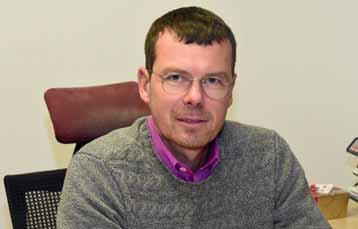
Mr Vetevool is uncertain how the new tax will affect the market price for salmon and will wait to see what happens in the New Year. He anticipates that prices will be very high. He recalls that in spring 2022 volumes were down in both Scotland and Chile and the price for salmon as shown by the Fish Pool Index soared reflecting the shortage of
fish on the market. After a few weeks prices came down again, but with the new tax the situation is more uncertain. It is likely to be painful for the company since only fresh raw material is used in the production. Only in dire emergency will they switch to frozen fish or frozen fillets. Ultimately, it is the consumer who is the final arbiter
of the price. In April and May 2022 when salmon fillets were retailing at EUR35/kg consumers deserted salmon on a large scale. Processors are squeezed between big producers of salmon and big retail chains, both of whom exert price pressure on the processor. We have learned to navigate between the two, says Mr Rajangu, and in 2022 we increased our prices twice and in January 2023 they will go up again. We have a strong position on the Estonian market and with regard to exports, our quality to price ratio is good compared with other exporters, but there is no escaping the influence of raw material prices. Producing the raw material themselves is not an option, firstly because Estonia does not have the geography to produce salmon and even farming trout is tricky, and besides, competing with Norwegian producers would be difficult.

And producing on land calls for massive investments, finding the financing for which would be difficult. The company experimented a couple of times with salmon from land-based farms, but discovered that the taste was different from the sea-raised product and so did not continue. Quality is very important for us, says Mr Vetevool, we cannot use a cheaper product if it compromises on quality
The factory where products for the domestic market are manufactured dates back to 1988. Since then, as the company grew, it expanded gradually until 2010 when the new plant was built, and salmon and trout processing was moved there. The site is located 100 m from the sea and employs some 35 people
making it the biggest employer in this rural area. This is one of the reasons why we keep it, Mr Vetevool says, as people need to work. Locally caught Baltic herring and sprat is not processed by the company, though small volumes are sold at the company shop on the premises of the new factory. But small quantities of common bream, perch, carp and African catfish farmed in Estonia are used by the company in the production. What is important is to have a stable supply of the raw material. The season for bream, for example, is September, October, November. This is when the quality is best so the company buys enough for the whole year and freezes it.
The impact of covid on the company was mixed. On the one hand measures were taken to secure the health and safety of the workers
and in terms of markets the Horeca sector closed. On the other hand sales to supermarkets increased. The war, on the other hand, is much worse, emphasises Mr Vetevool, because of the increase in energy prices. This affects us directly but also indirectly because it pushes up the prices of all our inputs, packaging, logistics, you name it. At the start of the year where we could get 2 m of packaging foil for a certain price, now we get only one for the same price. Food ingredients such as sugar, salt, oil, vinegar etc. have also increased, some have doubled in price others are up 3-4 times. Taken together there has been a huge increases in our costs, he states, with no respite in sight. Mr Ranjanku predicts that the hard part is yet to come. In January and February and good cheer of Christmas is behind them consumers will be looking to save. There are
ways to make food cheaper, says Mr Vetevool, the government could help, for example, by reducing VAT on food (currently 20) as they have done in Poland, where it has been removed altogether. Kairi Šljaiteris from the Ministry of Rural Affairs confirms that there are a few items on which VAT has a reduced rate such as medicines, books, some cultural services (and hotels! Mr Vetevool adds), but otherwise VAT is 20 and there are no plans to reduce it on food.
Angerja tee 32 Hürü, Saue vald 76911 Harjumaa
Estonia
Chairman of the Board: Meelis Vetevool meelis@mvwool.eu
Sales Manager: Hendrik Rajangu hendrik@mvwool.eu
Activity: Fish processing Facilities: 2


The impact of higher costs can already be seen on industry. Mr Vetvool points to companies—so far only in non-food sectors—that have had to close their doors. All the companies in the food sector have made losses in 2022, he adds. And national measures to support industry do not extend to companies with an annual turnover of more than EUR10m, so M.V. Wool does not qualify. However, it would be eligible for relief under the EMFF measures currently being processed by the government. But companies would prefer stable energy prices rather than going cap in hand to the government. And, according to Mr Vetevool, this should be possible because Estonia is largely self sufficient in energy. As a processing company M.V. Wool has high energy consumption because it needs to cool and freeze its products. If energy prices are not reined in, I fear food production will shift to Poland, he states. We need therefore to have a discussion on the importance of Estonian food security and whether it is strategic to maintain food production here, otherwise I foresee a sector in deep trouble, says Mr Vetevool.
Salmon and trout products for international and domestic markets: Cold smoked (main product), fresh and frozen fillets, gravad,hot-smoked, fillets, portions, party boxes
Other products for domestic market: Cod, catfish, eel, mackerel, herring, whitefish, hake, and redfish, which are marinated, salted, hot and cold smoked, fresh.
Export markets: France, Belgium Italy, Finland, Sweden, Denmark, Czech Republic, Latvia, Lithuania
Covid and the war in Ukraine affected the prawn fishery in the North Atlantic in different ways. The Estonian government offers the industry a helping hand.

The coldwater prawn (Pandalus borealis) is the main shellfish stock in the North Atlantic. Stocks are found on the continental shelves, in the Barents Sea and Svalbard, along the coasts of Murmansk (Russia), Norway, north eastern Jutland (Denmark), Iceland, Greenland and North America’s eastern seaboard. The prawn frequents depths between 200 and 500 m and prefers a temperature range of between 1 and 6 degrees C. Total catches peaked in 2004 and have since declined, showing a 50 reduction in 2017, before recovering slightly the following years.
At the International Coldwater Prawn Forum held in November 2022, Dr Carsten Hvingel from the Norwegian Institute of Marine Research showed that the status of coldwater prawn stocks in the West Atlantic has largely returned to where it was in 1990. In the East Atlantic the Barents Sea stock is still underutilised. Shrimp catches are influenced by cod catches—as the latter have declined so have the former. Warming water in the West Atlantic may also have an impact on shrimp stocks. Future catches in the West Atlantic are most likely to decline which will be partly compensated by an increase in the catches from the Barents Sea. Dr Hvingel also showed the relationship between the shrimp stock biomass and the diesel consumed per kg of shrimp
product. Consumption of diesel (and thereby carbon dioxide emissions) increases exponentially with reductions in the stock.
Reyktal and Reval Seafood are related Estonian companies with coldwater prawn catching operations in the North Atlantic. The latter is a joint venture between Reyktal and a Danish company, Ocean Prawn. The bulk of the catch is coldwater prawn, but small volumes of cod, Greenland halibut, and American plaice are also targeted. The two companies currently have three big (one 70 m and the other two 60 m) vessels between them—two in Reyktal and one in Reval Seafood. Covid affected transport links between countries affecting the movement of goods and personnel. Flight cancellations made it difficult to bring sailors to their destinations. Reval Seafood OÜ had to charter private planes to bring the crew back to Tallinn from Tromsø, where most of the product is landed and stored, because there were no commercial flights. The company also implemented several measures to limit the risk of infection as far as possible. These precautions applied not only to the crew on board the vessels but also to suppliers and included testing for covid both in Estonia and in Oslo and hotel rooms where workers could be quarantined when necessary. These measures hindered the transmission of the disease and as a result we had no big problems with covid, says Mati Sarevet, the managing director of Reyktal. Of
course, there were costs associated with the measures, and when members of the crew did contract the disease while on leave at home finding replacements was difficult, but the fishing activity was not seriously affected.
As the covid crisis tapered off the war broke out in Ukraine which brought its own complications. While border crossings returned to normal and restrictions on gathering and travelling were lifted removing the constraints the company faced during the pandemic, the price of fuel shot up. Reval Seafood’s fuel costs in 2022 doubled compared to a year ago, says Mr Sarevet, who is hoping that a government support
measure for increased fuel costs that opens in February 2023 will offer some relief. A fishing trip typically has a duration of four to five weeks, but a vessel’s fuel consumption cannot all be attributed to fishing. Fuel is also used to run the generators that supply power for all the other operations on board, for example, freezing, cooking, heating, and operating the trawling equipment. Mr Sarevet is well aware of EU commitments to reduce emissions but cannot see any immediate way of switching to a more sustainable energy source.
LNG is only a temporary solution and hydrogen is still not feasible, while synthetic fuels that are produced using renewable energy are still far more expensive than conventional fuels, so there are no readymade fixes yet. In the future when we build vessels we need to
ensure that they are sustainable in terms of the fuel they use and of their engines, but the technology is not there yet.
The companies will continue their activity of producing cooked, shell-on prawns, packed and frozen for the retail market. In addition, the vessels produce industrial shrimp. This is a raw frozen product intended for peeling plants and manufacturers of sushi. Among the clients for this item is a Japanese company and the vessels are therefore subject to monitoring by Japanese inspectors. The length of the fishing trips means that all the product must be frozen. Reyktal also operated a smaller vessel that fished nearer the coast making shorter trips of a week or ten days and storing the catch fresh in brine. Once on shore the prawns were packaged in modified atmosphere giving a shelf life of two weeks and were sold locally in Norway and Sweden. In both Norway and Sweden the market for fresh shell-on coldwater prawns is about 2,400 tonnes, according to the Norwegian Seafood Council. This corresponds to about 10 of the market for this species in Sweden and 25 in Norway.
Apart from prawns the company also catches fish using an additional collection bag above the shrimp cod-end to trap the fish. This “combination” fishing in NEAFC zone Ia Ib has been MSC certified since 2017, says Mr Sarevet. With this method a sorting grid in the prawn codend directs the fish to an opening in the roof of the cod-end while allowing the prawns to pass into the cod-end. The opening is fitted with a collecting bag which catches the fish. Combination fishing enables the trawler to target shrimp and groundfish simultaneously thus reducing the carbon footprint of the fish catching. Also, as the collection bag is placed atop the trawl there is no bottom contact. The method is used by EU vessels targeting shrimp in NEAFC zone Ia as well as by Norwegian vessels in Norwegian waters south of 620 among others, but it remains controversial with some countries fighting its use. The finfish species caught by Reyktal’s vessels using combination fishing include American plaice, Greenland halibut, and cod. In the year to September
Reval Seafood caught over 3,000 tonnes of shrimp while Reyktal (Merike and Steffano) caught 7,000 tonnes of shrimp. By the year end, Mr Sarevet expects about 10,000 tonnes of shrimp, 700 tonnes of cod, and some 250 tonnes of Greenland halibut. Volumes in 2022 were higher than the previous year, but it is market prices that are the critical factor. These have recovered somewhat from the covid lows but are still not as strong as before the pandemic. The combination of strong catches and decent prices has enabled the company to keep fishing despite the high cost of fuel. The product is sold on different markets including China and the Nordic countries.
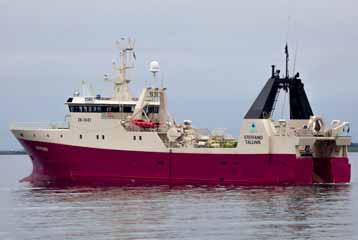
+372 627 6545 Fax: +372 627 6555 reyktal@reyktal.ee
Managing Director: Mati Sarevet
Activity: Fishing, processing on board
Fishing areas: NAFO, Barents Sea
Reyktal has been in the prawn fishing business for some 25 years, but among its partners is an Icelandic company that handles sales and has been operating for 50 years. The sales companies actually started the fishing business rather than the other way round, says Mr Sarevet. The connection with the Icelandic company explains the brand, Iceland Seas, under which Reyktal’s products are sold. Another brand is Ocean Seafood which comes from the Danish company, Ocean Prawn, that is part owner of Reval Seafood OÜ. The links and associations that Reyktal has formed across northern Europe should help it weather any crises that may crop up in the future as well.
Product: Cooked prawn, frozen whole prawn
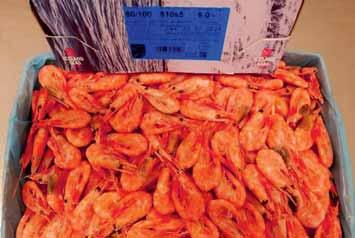
Volumes: Approx. 10,000 tonnes of coldwater prawn in 2022, minor quantities of cod, American plaice, and Greenland halibut.
Markets: Scandinavia, continental Europe, UK, China, Russia, Japan
Vessels: 3 (incl. 1 owned by Reval Seafood OÜ)
The Center of Food and Fermentation Technologies (TFTAK) was founded in 2004 as a non-profit with support from Enterprise Estonia, a state body, but in 2012 became a privately held company owned jointly by Tallinn University of Technology and four private companies.

TFTAK has two main areas of focus—biotechnology for the study of bacteria, yeast and fungi; and food for human consumption. Within the latter area of focus there have also been projects related to fish including one to study the feasibility of establishing a fish feed plant in Estonia.
In the food side of the business TFTAK does research and development on, for example, creating plant-based alternatives to meat and fish. The company currently has a team participating in an American competition (XPRIZE) to create a product that mimics fish. The team has been successful having reached the semi-finals in competition against big laboratories from private industry and other institutions. TFTAK has about 100 employees of whom 80 are scientists who are organised typically into teams of 6-10 people. There are also some 25 Ph.D students who do their research at TFTAK but earn their degrees from the university. TFTAK also does some core scientific research which brings in some revenue from the state, but the bulk of the income comes from projects funded by the private sector or from research grants. Martti Tamm is the chief
technology officer whose responsibility is to keep the laboratory running. He is also involved in projects to find ways of upscaling the processes developed in the organisation.
Estonia’s three fishing producer organisation joined forces a few years ago to establish a fishmeal production factory in Paldiski near Tallinn. Estonian Fish Meal and Oil, the company behind the fishmeal factory, is looking at ways to valorise the production and commissioned the feasibility study. According to Mr Tamm the fishmeal factory has been successful with sales of fishmeal to customers in different parts of the world and now sees advantages in moving up the value chain. TFTAK has worked with the fishmeal factory on developing recipes for petfood and pet treats based on fishmeal. Mr Tamm has also worked on a project to treat the wastewater released by the fishmeal factory. It was a very specific challenge that the factory faced and TFTAK worked on the filtering technologies used to clean the wastewater. This involved optimising processes to separate and concentrate materials in the wastewater and to find out how to introduce filtration because the equipment is expensive and the unit price for fishmeal is quite low. Price is a critical parameter as—even if the technology works well—if the acquisition price or
the running costs are too high it cannot be deployed.
In the wastewater treatment project researchers from TFTAK analysed the wastewater and looked at ways of concentrating and recovering useful or harmful compounds, for example nitrogen and phosphorus. These can be used as fertiliser and can save on running the cleaning devices. If done properly the wastewater may not even have to run through mud baths but can
be disposed off directly through the drainage system. But for now it is cheaper to use the mud baths than to use the filtration technology. Another project involved exploiting an invasive fish species, the round goby ( Neogobius melanostomus ), that has colonised the waters of the Baltic. Fishers were reluctant to catch the fish as there was no local market for it, so researchers at TFTAK developed ways of processing the fish into attractive products. Partly due to their efforts the fish has become popular among Estonians and now the issue is more that catches of the fish have declined so there is not enough to satisfy the market.
The fish feed project will be a link in Estonian ambitions to increase annual aquaculture production from 1,000 tonnes to 10,000 tonnes by 2025. Most of this volume will be generated from marine aquaculture. Covid in particular showed how international transport could be suddenly blocked and highlighted the need for greater selfreliance. Although there are fish feed plants in Finland, Denmark, and the Netherlands which export to countries in northern Europe, there was a need to study the possibility of establishing one in Estonia too. The study looked at feed for portion sized trout grown in freshwater and large trout grown in the sea as well as for sturgeon grown in
intensive farming systems. Among the preliminary conclusions was that taking over the physical assets of a plant in Finland may create an economically viable solution as it would produce volumes large enough to also supply the Finnish market. Another scenario where a factory with lower capacity was established was not economically feasible. The report also referred to the additional needs of an independent feed company in terms of research and development, sales teams, and quality control facilities. It would also have to contend with long established feed mills in the wider region that already export their products to markets that the Estonian factory would target. The full report (in English) is publicly available at eng_1_Pre-design_ phase_I_Feasibility_Study_Aquafeed_Mill_Estonia_Final_Report. pdf (kalateave.ee).
Apart from the highly knowledgeable people working at TFTAK, the institution boasts a pilot facility that reproduces on a smaller scale all the technologies used by the food industry, so processes and products can be tested and then scaled up if necessary. This makes it attractive for companies (startups or others) who may want to test ideas but lack the facilities to do it. Companies are also interested in the institution’s ability to cultivate things (bacteria, fungi, yeast) as well as its in-house analytical capabilities—chemical, physical, sensory, and DNA studies. Within the area of food efforts are shifting away from meat and fish towards alternatives such as fungi, plantbased products, and even insects. This direction is driven by market developments. Plant-based milks, for example, now account for 16 of retail milk sales in value in the US, according to the Good Food Institute. Companies are getting more interested in these alternative sources of food and TFTAK is adapting in response. Plant-based products do not taste as much as traditional products and so some development work is needed to change this. The plant-based fish that was the entry for the XPRIZE had to reproduce the texture of fish which was quite a challenge as it is so much softer than meat yet has a distinct texture. Matching the taste of fish was not as
difficult but people who eat fish regularly need to be deceived into thinking they are eating fish. Mr Tamm suggests that future generations, who are more used to eating plant-based products, will be slower to compare plant-based fish with the original and quicker to accept it even if it is not a perfect reproduction.
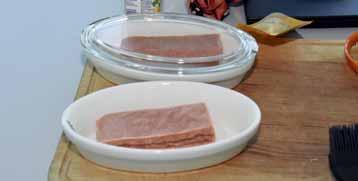
The center serves not only Estonian companies, but foreign ones as well, which are responsible for over a third of the turnover and rising. We cannot grow further in Estonia, says Mr Tamm, so we have to sell our services outside. Papers by the center’s scientists in reputed journals and presentations at international conferences have drawn the attention of food companies to the existence of this institution, the research it carries out, and the services it offers. Participating in events like the XPRIZE also bring publicity to the center and its staff. To formalise its promotion efforts the center has recently hired its first sales and communication staff member, but scientific papers and presentations will remain an important part of its outreach strategy.
Mäealuse 2/4
12618 Tallinn, Estonia
info@tftak.eu tftak.eu
Head of Engineering: Martti Tamm
Divisions:
– Bioprocess optimisation including cultivation technology and cultivation
equipment for bacteria, fungi, and yeasts;
– Food research including functional foods, plant-based meat, plant-based dairy, plant proteins;
– Analytics including chemical, physical, sensory, metagenomics.
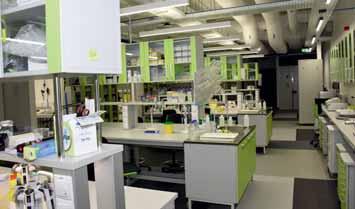
Employees: 100
Ph.D students: 25
Partners: 50
Microalgae are amazingly versatile. They are a source of omega three fatty acids, antioxidants, and other useful compounds and they have a number of useful applications including in the food, feed, and pharma industries as well as in bioplastics, biostimulants, and biopesticides. They can also be deployed to remove nutrients such as nitrogen and phosphorus from effluents produced by water treatment facilities or fish farms.
However, production of microalgae at scale is often constrained by unfavourable economics. Notwithstanding this, companies convinced of the potential of microalgae have been established from the north to the south of Europe. Their optimism is based partly on the knowledge that microalgae can contribute
to several European Commission strategies such as the European Green Deal and the Farm to Fork strategy and are highlighted in the EU’s strategic guidelines for sustainable aquaculture. Further emphasising the importance the European Commission places on algae was the adoption of the algae initiative towards the end of 2022.
About a decade ago, algae were generating a lot of headlines in the US about their potential to produce biofuel in volumes that could even compete with oil. This did not materialise
and funding for the sector largely evaporated as disappointed investors decided that algae were good for nothing. Against this backdrop, Power Algae was founded in Estonia in 2013 by two students, Dr. Liina Joller-Vahter and another graduate student working towards their Ph.Ds in economics at
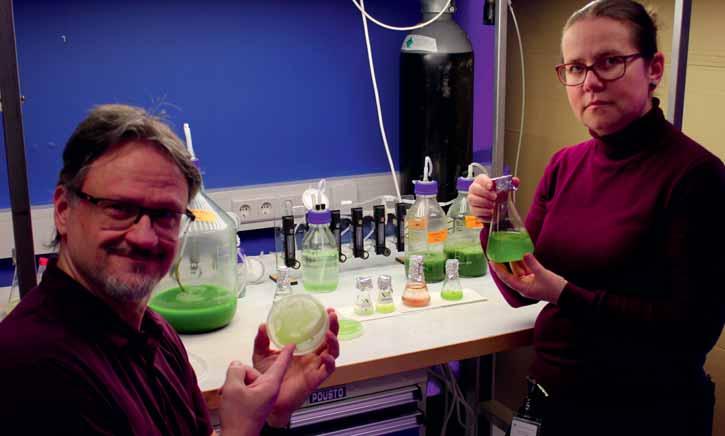
the University of Tartu. Both of them were interested in innovation-related topics and, after reading the literature about microalgae, started to put together a team with expertise in mechanical engineering, biology, chemistry, and other relevant fields. The main partner since then has been the Estonian University of Life Sciences. The collaboration with the university and the inclusion of mechanical engineers on the team meant that Power Algae’s focus at the beginning was on the design and construction of equipment to cultivate microalgae rather than downstream processing, which has come on the agenda more recently.
Over the last decade the company only produced microalgae in small volumes but it has accumulated a lot of knowledge and now is in a position to start upscaling. Power Algae has generated revenues by providing expertise in bioremediation, designing circular systems, evaluating market potential of blue bio technologies, and in other related fields, but it has not produced and sold algae biomass on a large scale. The company does not focus on a single sector but is interested in food, feed, nutraceuticals, and pharmaceuticals. Microalgae are a potential source of important nutrients such as proteins and fatty acids but, she cautions, it is to be taken in very small doses, as a tablet perhaps or through enriching another food product, but not consumed “as a porridge”. People in Asian countries have been eating macro- and microalgae for centuries, and there may be pockets of Europe which have a history of algae consumption, but in general European production and consumption of algae is miniscule.
Algae production for food purposes falls under the novel food regulation in Europe which currently only allows a few varieties of algae to be consumed, though this is changing gradually. According to Dr Joller-Vahter many producers feel that they could belong under aquaculture or under agriculture or under processing but that none of the regulations are actually tailored to the algae sector.
As a feed, microalgae are ideally suited to juvenile fish since it is often part of their natural diet in the wild. But trials include testing the benefits of microalgae in feeds for cattle, pigs, and poultry. The presence of red pigments in some strains of algae gives egg yolks and also salmon flesh a darker colour. Dr Joller-Vahter says that the use of algae in feeds is of particular interest because it is also supported by the European Commission, which would like to find alternatives to soy protein in the feed formulas used both in aqua- and agriculture. But competing on the market for protein, which is traded like a commodity today, is very difficult for producers of microalgae. That said, juvenile fish in general and adults of certain fish species are potential markets for feeds enriched with microalgae, which beyond being a source of lipids and proteins also have antimicrobial components. Hence, a feed formula with a microalgae component serves not only nutritional purposes but also enhances fish health. At Power Algae several species of microalgae are being studied. There are hundreds of strains of microalgae that appear in nature of which only a very few have been scientifically investigated. At Power Algae the species being studied include both native and exotic varieties.
The focus on cultivation systems throws up its own challenges. Microalgae can be grown in ponds or raceways as well as in closed systems. Since the climate in Estonia is not favourable to grow microalgae in ponds or raceways, Power Algae uses closed systems called bioreactors. These come in different shapes and sizes, starting from a few litres and reaching several hundreds of cubic metres for full scale production. Here both autotrophic and heterotrophic (those that do not need light for growth) microalgae can be cultivated. When necessary, LEDs provide the light and nutrients and carbon dioxide are added to the bioreactor to stimulate growth of the microalgae. What is important is that all the microalgal cells have access to all these elements, a condition achieved by optimising the circulation of the medium in which the nutrients and the carbon dioxide are dissolved. The microalgae are unicellular organisms and one of the challenges is to ensure the culture does not get contaminated with, for example, another strain of microalgae.
Microalgae are cultivated in bioreactors in several countries in Europe. Southern countries have the advantage of bountiful
Riia 181a
Tartu 50411 Estonia
Founder and co-owner: Dr Liina
Joller-Vahter
Area of activity: Design of equipment for microalgae cultivation and processing
sunlight and a long warm summer season. On the other hand, cooling costs need to be taken into consideration as ambient temperatures can rise to well over 30 degrees. Most currently commercially cultivated microalgae thrive at temperatures between 15 and 25 degrees. In the north there is not enough sunlight, so LEDs that run on electricity must be used, which is a cost factor. But cooling, which demands energy and water, is not an issue. Heating too is relatively inexpensive as, at least in Estonia, there are abundant sources of excess industrial heat which can be used for the production. When the microalgae is to be harvested several techniques are available, says Dr Joller-Vahter, and the choice of method depends essentially on which is the most cost efficient in terms of both time and energy. But it is also influenced by what the biomass will be used for afterwards. At Power Algae researchers are looking at ways to increase the biomass and at the same time also at ways to increase the content of a specific component within the biomass, for example, lipids, proteins, or pigments. After almost a decade of building up our knowledge and international collaboration network we are now starting to scale up our own production, and are open for collaboration on the feed, food and pharma applications, says Dr Joller-Vahter.
Uses of microalgae: Ingredients for food, feed, and pharma; water treatment; carbon capture
Employees: 3
Main partner: Estonian University of Life Sciences
Only around 9 percent of the plastic produced worldwide is recycled. The vast majority is incinerated, ends up in landfill or in the sea and permanently pollutes the environment. It takes centuries before it breaks down into microplastics. Plastic waste in the oceans is a pressing problem that the fishing industry and aquaculture are also contributing to. Could nets and lines made from biodegradable plastics perhaps be a solution?
Synthetic organic polymers, usually referred to as “plastic” for simplification purposes, are today the most widely used man-made artificial material across the globe. Plastic can be produced in a wide variety of forms and used in different ways. From water bottles and disposable medical supplies to food packaging, clothing and lots more. The inert, durable and almost nontoxic material was seen as a good choice for many applications for a long time. Plastic has become ever-present, if not indispensable, in our convenience-based lives. More than nine billion tonnes of plastic have been produced worldwide since the 1950s. There were hardly any concerns about releasing plastic into the environment at that time. However, since then concern over environmental pollution caused by plastic has been growing. After all, every person disposes of an average of 52 kg of plastic waste per year. Much of this ends up in the sea, and plastic pollution there is now seen as a significant global environmental problem. Given the size of the problem, the attempts by some states to stem the growing tide seem to be almost in vain. The problem will not be solved by banning single-use cutlery and plastic cups. Plastic is not being successfully recycled everywhere by a long stretch. Even the International Convention for the
(1978 version) did not appreciably reduce the pollution burden on the oceans, if at all.
However, marine pollution is seen as a major and urgent problem by consumers worldwide. In a survey of more than 20,000 consumers carried out by GlobeScan on behalf of the Marine Stewardship Council (MSC), two-thirds of participants said that they were particularly concerned about the pollution of the seas. Vigorous countermeasures are urgently required, and above all preventative action, since once plastic has reached the ocean, it cannot be removed again, or can only be removed with a great deal of effort. Each potential contributor of plastic waste must make their own contribution towards keeping the seas clean. This includes the fishing industry and aquaculture, which are among the biggest polluters. According to estimates from the conservation organisation WWF, lost fishing nets account for one tenth of global marine waste. Apparently, approximately 640,000 tonnes of fishing gear is lost in the oceans each year, or is “cost-effectively” disposed of there. However, the term “cost-effective” is not accurate, since the environmental, social and economic follow-up costs of abandoned, lost or
discarded (ALDFG for short) fishing gear made from synthetic fibres and plastics, which often remain in the oceans for centuries as ghost nets, are significant. They damage aquatic habitats and kill fish, marine mammals and sea birds that get caught in the net mesh. And even if the fishing gear then eventually breaks down into tiny particles and becomes
pulverised into microplastics, these remain a permanent hazard, as they can enter marine food chains and harm marine animals.
Fishing gear such as nets, fish traps, lines or lures made from polypropylene, high-density polyethylene

or nylon has even been found at the edge of the Arctic and in deepsea trenches, and is said to make up approximately 46 of the Great Pacific Garbage Patch. None of these types of plastic is naturally biodegradable and therefore they also do not return to natural materials cycles. The question therefore almost inevitably arises: why not turn to biodegradable plastics to manufacture fishing gear with a limited lifespan that can break down by itself after a certain amount of time? Even if this took two or three years, this would be a lot better than current plastic materials that last for 500 or 600 years. There are already plenty of existing models for this, such as compostable bags or packaging nets made from bio-based fibres that are manufactured from potatoes, sugar cane and other renewable resources. Most have similarly good properties to synthetic plastic, are break-proof, can be mechanically filled and have high seal strengths.
Bioplastics are not a cure-all for the plastic problem, but they are at least less environmentally damaging than conventional materials. Manufacturing them uses up hardly any fossil-fuel resources and has a reduced CO2 footprint. They break down more quickly in the wild and are less toxic. For example, they do not contain any bisphenol A (BPA), which is present in many standard plastics and can disrupt the hormonal balance of humans and animals. Fishing gear made from biodegradable material would also meet the United Nations SDG Goal 14.1 for sustainable development at an economic, social and environmental level that aims to prevent marine pollution of all kinds. It would also contribute towards SDG Goals 12.3 and 12.5, which call for the reduction of
food losses along production and supply chains (ghost fishing causes fish losses in the production chain) by 2030.
But what are bioplastics and what does “biodegradable” mean? In principle, every plastic ages and degrades, including standard materials. However, these only break down into tiny particles or powder (microplastics) which do not return to the natural cycle. Biodegradable plastics such as products made from polylactic acid (PLA), which are mainly manufactured from sugars in maize starch, manioc or sugar cane, can in contrast be completely broken down by microorganisms into water, carbon dioxide and compost under the right conditions. According to the current definition, biodegradable means that the plastic must be 90 broken down within 12 weeks at a temperature of 60 degrees. This is relatively fast, but it does always
take significantly longer than for normal organic waste that is produced in the household or garden. Shopping bags or yoghurt containers made from PLA, for example, take about three months to break down, while organic waste only takes two to three weeks. This is why biodegradable plastic cannot also be disposed of in the compost bin, because it would disrupt the technological processes in composting facilities due to its longer decomposition period.
What makes the search for biodegradable alternatives for the fishing industry and aquaculture exceptionally difficult however, are the extremely demanding requirements in both sectors. In contrast to traditional nylon nets, biomaterials
seldom have the required tensile strength and the necessary mechanical performance features. Their relatively rapid decomposition following a net loss is an advantage, but it can increase the susceptibility of the fishing gear to breaks and thus increase loss rates. If the necessary certainty is lacking that the caught fish can actually also be hauled on board, because the net becomes increasingly fragile with age, it will likely be difficult to inspire enthusiasm for the new materials in potential users. All the more so as biodegradable nets are more expensive than traditional gear and need to be replaced more often due to their limited durability. There is also the issue that replacing the synthetic nets alone is not enough. This is because other equipment made from plastic is used in fishing that can be lost and then take centuries to break down into microplastics, which are potentially even
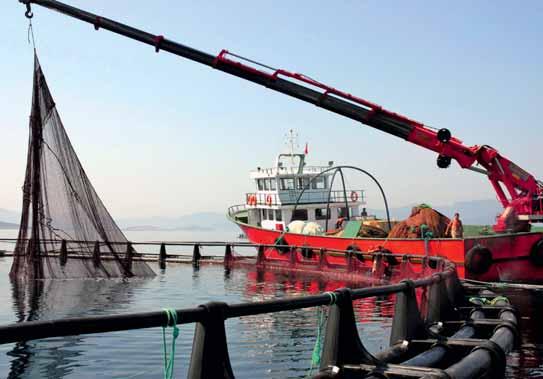
more environmentally damaging than the original equipment. This includes anchor cables and lines, fishing lines, floats and artificial lures, to name just a few.
There still does not seem to be any ultimate solution to this global problem, but there have already been numerous initiatives such as the idea of biodegradable net materials. In Europe, politicians are taking a two-pronged approach to conserving and cleaning up the seas. Conventional plastic nets that are lost are to be retrieved to a greater extent, and the recycling of old nets in ports is to be improved. In addition to this, large-scale studies are attempting to discover whether conventional nets can be replaced by biodegradable materials. The requirements for biodegradable nets are demanding, as they must be similar to current fishing gear with regard to durability, handling, efficiency

and cost. For example, as part of the E-REDES project in the Northern Littoral Natural Park (Portugal), gillnets made from biodegradable monofilament yarn that can be broken down by microorganisms after two years in sea water were tested under practical conditions. The experimental yarn has a similar breaking resistance to standard nylon monofilament, but is somewhat stiffer, which makes handling it more difficult for fishers.
The four-year, 4.2 million euro Innovative Fishing Gear for Oceans (INdIGO) project of the European Union’s Interreg programme, which is ending in June 2023, aims to develop the first completely biodegradable net with a controlled lifespan. Within two years, it should break down organically into natural materials, instead
of microplastics. INdIGO also intends to show the way towards a suitable strategy for improving the recycling of worn-out fishing gear. The researchers involved have developed a mobile app that makes it easier to locate lost fishing gear. This important project is contributing to reducing the plastic waste in the Channel region between Great Britain and France by 3 by 2030. The INdIGO project also includes a survey of fishers that was carried out between December 2020 and August 2021. This showed that three quarters (73) of respondents would consider using biodegradable fishing nets if the material and gear was similarly robust, solid and efficient as standard nets. Environmental arguments therefore also convince fishers and encourage them to convert to biodegradable fishing gear. However, because biodegradable nets are significantly more expensive –currently higher costs of around 10 are assumed, which are
incurred more often due to the shorter usage duration of the nets – the changeover of course also depends on the financial framework conditions. This presents the question of whether consumers and politicians are really prepared to shoulder these additional costs. For example, through higher retail prices or corresponding subsidies.
The introduction of a voluntary sustainability standard (VSS) for biodegradable fishing has been considered as a possible solution to this problem. Similar standards are sometimes used already for coffee and cotton. Such a certificate could increase consumer awareness regarding the efforts of fishers towards sustainability and protecting ecosystems, which would hopefully provide them with improved market access and higher income.
In Mutriku in northern Spain, scientists from the AZTI research centre are working on replacing plastics used in aquaculture with more environmentally friendly materials as part of the European BIOGEARS project. This particularly relates to mussels, which grow on long cables in suspended cultures and are protected from predators by outer net walls. The cables and nets are made of plastic, which becomes a problem as soon as their useful life has come to an end. In the BIOGEARS project, the researchers involved are working on converting production to biodegradable plastics. Cables and nets made from natural materials that come from renewable biomass, such as from plantbased sugars, are being tested. The results to date have been encouraging, as tests with various different material recipes have resulted in promising approaches for further development. Net
weavers and cable manufacturers, whose machines are really designed for processing standard plastic granulate, have in many cases given the green light. Conversion to compostable material was possible with only minimal adjustments.
The EU OCEANETS project is not just about biodegradable nets, this initiative is also about preventing, retrieving and recycling plastic waste in the oceans. It is well-known that sometimes parts of nets, or even entire nets, are lost on fishing trips by fishing vessels in rough seas or on sharp rocks. This is why the researchers in this EU project have developed a Web-based tool with which fishers can report the location and time of the event following such a
loss. This means that other fishers are informed almost in real time of the risk of net losses in this area and can avoid the location. Moreover, OCEANETS aims to advance the development of new chemical and mechanical technologies for recycling old nets. Currently, a technology where the nets are cut into tiny bits and then melted down is favoured. This process, called compounding, produces a granulate from which synthetic yarn for functional and sports clothing can then be manufactured.
But work is being done on reducing net waste made from plastic in the seas in other locations across the world as well, not just in Europe. In South Korea, for example, where researchers from the National Institute of Fisheries Science in cooperation with the FAO already introduced biodegradable
nets in 2016. The net yarn used, a polymer monofilament made from 82 polybutylene succinate (PBS) and 18 polybutylene adipate terephthalate (PBAT), has been shown to have similar durability to nylon in trawl net trials. Following its normal useful life, it is broken down by microorganisms in sea water in only two years, which significantly reduces the potential risk of ghost fishing. The new bionet was just as good at catching as standard nylon nets, which means it is very much financially worthwhile to use it, and its acceptance among fishers is gradually improving. Many still reject such nets, because biodegradable nets break and can be lost more easily than previous fishing gear and also cost more. Despite their many advantages, bioplastics are certainly not a cure-all or a magic bullet for combating net waste in seas and preventing ghost fishing.

However, they can ameliorate the problem, particularly since new approaches to solving these problems are on the way.
Recently, a plastic has been developed that is as stable as nylon, but breaks down when exposed to UV radiation for an extended period. Intense sunlight causes numerous breaks in the polymer chains (photolysis), causing the plastic to quickly crumble. It is made from isotactic polypropylene oxide (iPPO), which has been around since 1949. Changing the chain length and alignment of its basic elements made this polymer so mechanically stable that it meets the requirements of the fishing industry, for example, for ropes or fishing nets. In laboratory tests, the polymer chains of the plastic degraded to a quarter of their original length within just 30 days. If researchers succeed in pushing development to the point where the material degrades almost without a trace under UV light, this could be an important contribution to reducing plastic waste in the sea. There is therefore some way to go before current nets can be replaced by biomaterials. Among other things, we must better understand what factors influence decomposition in the sea in order to be able to take a more targeted approach. Then perhaps the design of the polymers can even be tailored to specific requirements, so that the nets can be used effectively by fishers for a certain amount of time and, following a potential loss, can completely break down into harmless substances without residues and in an environmentally-friendly way.
Manfred Klinkhardt


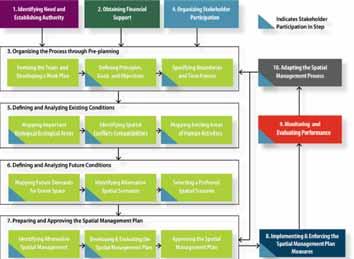
Crowded oceans, polluted seas, and marine resources at risk—this is the context from which Maritime Spatial Planning (MSP) emerged, with the ambitious goal of resolving some of the challenges our blue planet is facing: in other words, to balance the demand for development and the need to protect marine ecosystems.
Maritime spatial planning is a multidisciplinary planning tool, supporting both maritime economic development and environmental conservation, while seeking to resolve and prevent conflicts among maritime activities or with the ecosystem. It is a process of analysing and allocating the spatial and temporal distribution of human activities in marine areas, to achieve ecological, economic, and social objectives. It is a public and a political process, combining bottom-up and top-down approaches, and can extend from local to transnational scales (IOC-UNESCO, 2009). Through a continuous and iterative process, MSP goes through several steps. This process is illustrated in Figure 1 proposed by the UNESCO-IOC’s step by step approach (2009):


At a European level, a series of strategies and policies led to the establishment of the MSP Framework, namely the Integrated Maritime Policy (2007), the Marine Strategy Framework Directive (2008), the BIue Growth Strategy (2012) and finally the Maritime Spatial Planning Directive (2014). These set the stage for the
development of plans across Europe (a legal requirement for Member States). Today, Member States are not all at the same level in terms of designing and adopting their maritime spatial plans, and understandably so. Variations in governance schemes, sea basin specificities, marine space extent, and transboundary collaboration mechanisms explain the difference (Figure 2).
In 2017, the Directorate-General for Maritime Affairs and Fisheries (DG MARE) and the Intergovernmental Oceanographic Commission of UNESCO (IOC-UNESCO) joined their efforts to advance marine spatial planning globally, through the implementation of the MSProadmap. The first MSProadmap (2017-2022) gave birth to the MSPglobal initiative and the International MSPforum. The updated MSProadmap (2022-2027) focuses on six priority areas, centred around people and the ocean, underlining the beneficiaries of MSP. The priority areas consist of three cross cutting pillars (knowledge support, capacity development and awareness, transboundary cooperation) and three thematic pillars (climate-smart MSP, marine protection and restoration and sustainable blue economy).
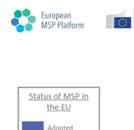
Transboundary collaboration is an essential element of MSP processes and is in fact laid down in EU law. The EU Strategy for the Baltic Sea Region (BSR) was the first regional strategy that integrated “Save the sea” as one of its core objectives with the aim of developing a common approach for T (transboundary) MSP in the Baltic Sea Region. The Baltic Sea has since developed extensive experience in this area particularly because most of its coastal countries are EU Member States and abide by the same regulations and follow the same directives and legal frameworks.
In addition, formal institutional collaboration is driven by two regional intergovernmental organizations, the Helsinki Commission (HELCOM), and Vision and Strategies around the Baltic Sea (VASAB). In 2010, the HELCOM-VASAB MSP Working Group was established to support the implementation of MSP in the Baltic Sea Region. To support this, the Pan Baltic Scope project (2015-2017) brought together eight MSP planning authorities in the Baltic Sea Region with the objective to achieve coherent MSP and build lasting macro regional mechanisms for cross-border cooperation. The project identified a set of challenges to and enablers of the implementation of MSP processes when multiple countries’ planning authorities are involved.
The main challenges identified by project partners were differing national interests and priorities, countries being at different stages of the planning process, changes in governments, a lack of clear definitions of MSP principles to work with, a lack of time or specificity to tackle certain issues, a low level of stakeholder involvement which limits the input needed in the proper functioning of the planning process. As for the enabling factors, clear communication and dialogue is deemed essential (particularly considering language barriers), identifying clear and concrete methods and tools for working together, financing to maintain a strong cooperation, and collaboration between national authorities, and finally, a strong, clear, and continuous stakeholder involvement practice.
The MSPglobal initiative was launched in 2018 to develop international guidelines on MSP in support of the sustainable blue economy, to improve cross-border and transboundary cooperation in areas where it exists, and to promote MSP processes in areas where it is yet to be put in place. These objectives were achieved through several actions, including performing two pilot regional projects
(West Mediterranean and Southeast Pacific), the development of storytelling tools, organization of national trainings on sustainable blue economy, publication of several studies and guidebooks relating to coastal management and MSP/ Blue economy. The ultimate goal is to triple the marine area benefiting from MSP by 2030.
The International MSP forum, over the past few years, has been a space to share valuable experiences and lessons related to MSP. Until now five fora have been organized, engaging hundreds of participants
“Data in MSP is key.” Transitioning from “data” to “knowledge” is a multilayered process as the world of knowledge has multiple dimensions and considerations. Who possesses and produces knowledge? Under which format? How is knowledge shared? With whom? When is knowledge shared, and at what stages of the planning process? What are the challenges facing member states and policy makers? These were some of the questions Ms Andrea Morf (Nordregio) aimed to answer in the first session of the MSP forum, sharing experiences from the Baltic and North Sea. Production—or co-creation—of knowledge is the collaborative work of scientists, practitioners, marine planners, and even artists and other creative types. Bridging the science-policy gap entails various types of interactions, from basic or applied research to consultancy and advisory services, all the way to concrete policy design and management. The production process needs to consider the quality, interoperability, and reliability of the content, in anticipation of the sharing procedure.
From the experience in the South-West Baltic between Sweden and Poland, learning and problem-solving are positive by-products of data sharing. In the field of fisheries, visualizing fishing efforts through heat maps, and crossing national interests with the Common Fisheries Policy, enabled policy solutions for shared fishing grounds to be devised.
In the case of shipping and offshore wind farms, the Swedish-Polish mapping exercise helped solve conflicts, whereby Poland adapted their wind farm areas to accommodate passenger ferry corridors. In transboundary contexts, knowledge provision differs depending on the planning systems. Governments appoint different MSP authorities, produce data for different purposes, and the coordination of data is not homogenous. Through multiple learning loops, a wide array of methods, tools and modelling exercises are being developed throughout the planning cycle to accommodate these differences.
The main challenges identified were gaps in knowledge on certain topics (such as the social dimension), fragmentation of knowledge production, quality and reliability of data, spatial/temporal resolution of data, communication, and confusion about some terminologies, knowledge asymmetries among stakeholders etc. In the end, Ms Morf mentioned a number of projects and initiatives which contribute to the harmonisation of knowledge in MSP, through funding, capacity building and awareness raising. The round table discussions were a forum for MSP experts from around the world to share their personal experience and recommendations.
with different backgrounds and interests related to MSP, coming from over 50 different countries. The latest forum took place on 21 November 2022 in Barcelona, after a two-year break caused by the pandemic. The interactive and informal setup of the MSPforum
provided a platform for exchange and debate between different MSP actors. Round tables, dialogues and panels shaped this event, while keeping the discussion linked to the six cross cutting and thematic pillars. The report will soon be available on the MSPglobal website.
The 3rd MSP international conference took place back-to-back with the MSPforum on 22-23 November 2022, and also aimed to reflect the six priority areas of the MSProadmap. The conference offered panel discussions,
e-poster presentations, and speakers used sli.do to interact with the large number of participants throughout the two days. The conference was a unique opportunity to gather MSP practitioners from all over the world to share their experiences and exchange best practices related to MSP. A networking opportunity among peers, but also between
countries sharing marine space, economic priorities, and potentially marine spatial plans.
For more information:
Vera B. NOON
Marine Spatial PlanningArchitecture
Ocean Literacy & Marine Policy @ACTeon
Tel.: +33 7 84543589, +39 339 3496771
vera.b.n@hotmail.com
Further reading: MSP in a nutshell video; Marine Spatial Planning: A step by step approach toward ecosystem based management; MSPglobal International Guide on Marine/Maritime Spatial Planning.
The Russian fisheries sector is facing the deepest crisis in its modern history as ever tightening sanctions and growing international isolation seriously delay the building of new fishing vessels and stymie the investment plans of local fishermen.
Prior to 24 February 2022, the Russian fish sector had been steadily growing both in terms of catch dynamics and in the size of the fishing fleet. An official spokesman of Ilya Shestakov, head of the Russian Federal Agency for Fisheries (Rosrybolovstvo)—the Russian fish regulator—said in an exclusive interview that while the massive renewal of the fishing fleet in Russia began in 2018-2019 (thanks to the launch of major investment programmes by Russian fishermen) the industry has faced serious problems in recent months. The military conflict between Ukraine and Russia has put an end to plans for the further development of the industry with the same growth rates as in the past and has had a negative
impact on the Russian shipbuilding segment.
Until now, most new fish trawlers in Russia have been built on the basis of quota distribution schemes—the mechanism by which quotas for catch in domestic territorial waters for local fisherman are provided in exchange for building of new fish trawlers and processing plants. As part of the first stage of the quotas’ distribution, according to German Zverev, president of the All-Russian Association of Fisheries (VARPE), there were plans to build 105 fishing vessels, including 41 crab catchers, worth RUB 250 billion. Of these, building of at least 43 fishing
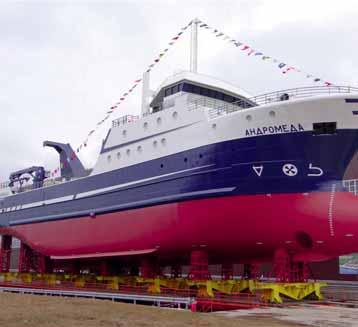
trawlers was supposed to be completed by the end of the current year, however, due to the current crisis in Russia their commissioning will be seriously delayed.
This has been recently confirmed by German Zverev who has said that out of 36 fishing vessels and 7 crab catchers, which should have been commissioned by the end of 2022, only 10 ships have been built (three of them crab catchers), while new ships will appear no earlier than 2026-2027 although according to initial state plans all the construction works were supposed to be completed by 2024-2025.
According to analysts from the Russian shipbuilding monopoly—the United Shipbuilding Corporation (USC), one of the reasons for this is Western sanctions, which led to a 2- to 3-fold increase in construction costs for Russian fisherman. The imposed sanctions also prevented fishermen from receiving on-board equipment (primarily those for on-board processing) for their ships from abroad. Most Russian fisherman initially planned to
install the maximum sophisticated equipment on their future vessels. Most of this equipment (with rare exceptions), was supposed to be supplied to Russia by «unfriendly» countries. This forces local fisherman to consider redesigning their future trawlers and finding alternative equipment for them. According to Russian analysts, in addition to on-board processing equipment, the biggest challenge is currently
observed with the supply of navigation equipment, along with engines, which were previously supplied to Russia from Poland, Germany, Finland, and even Ukraine. Analysts at the Russian Union of Fishing Collective Farms of the White Sea estimate the share of imported components in fish trawlers built at Russian shipyards to be about 80.
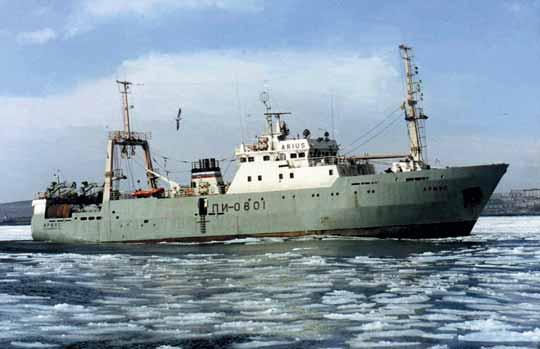
As most such supplies from Western states have been suspended since 24 February 2022, there is a possibility that equipment and components could be acquired from Chinese suppliers. However, most local analysts believe switching to Chinese supplies will delay the construction programmes by at least 2-3 years with a significant increase in construction costs. According to German Zverev, the refusal of Western suppliers to supply equipment ordered and partially paid for to their Russian customers will lead to a long delay in construction. He also added that despite this, domestic enterprises are
still obliged to fulfill their financial obligations to banks, which provided their loans for the building of these trawlers. According to data from VARPE, the total debt burden of the Russian fishing industry already exceeds 450 billion rubles (US$6.55 billion), more than 50 of which ca be attributed to enterprises, which build fishing vessels under the investment quota programme. The commissioning of the majority of trawlers will therefore probably be postponed until 2026.
Most analysts believe that this will have a significant negative impact on the industry, as the renewal of the fishing fleet in Russia has been declared one of the priorities of the Russian state and of local fisherman in recent years. Vessels that have been in operation for 25-40 years in the Russian fishing sector are estimated at 70 of the fleet, while those more than 40 years old amount to 12.

In the meantime, despite the current problems of Russian fisherman, the government is ready to conduct the second stage of the quota distribution scheme already next year (2023). As part of this, there are plans to build another 30 fishing vessels, as well as 35 crab catchers. According to state plans, about 300 billion rubles (US$4.47 billion) are supposed to be allocated for the needs of the industry, while budget revenues will reach 200 billion rubles. Still, a significant number of local analysts have serious doubts about the ability of the state to implement these plans, considering the current situation in the country. As the situation in the industry deteriorates, leading Russian fisherman have called on the state to provide additional support. Most of this support will be used to complete the building of new trawlers.
Representatives from VARPE have said that the current measures of state support are insufficient, as they do not stimulate the construction of fish trawlers in Russia, and most local fishermen still prefer to buy used vessels abroad due to lower costs and less risk of delays in construction. Since 24 February 2022 the cost of building trawlers at Russian shipyards has significantly increased, which has forced Russian fisherman to consider the choice of South Korea and other shipyards in the Asia Pacific for their ships. According to Kommersant, a business newspaper, shipyards in Asia have traditionally been cheaper than those in Russia, but in recent months the difference has become even more substantial. For example, in China, a 56-meter-long crab catcher costs
three times less than a similar vessel built in Russia as part of investment quotas. However, due to current restrictions, imposed on Russian fisherman and Russian business, building of Russian vessels in Asian shipyards has become seriously complicated. Fishermen are therefore hoping for an increase in support from the state and German Zverev has noted there is a need for a more efficient system of state support for the construction of the fishing fleet and import substitution of ship equipment.
Among the planned support measures are subsidised rates on loans provided for building of new trawlers, additional capitalization of shipyards by including them on the list of industries that will be allowed duty-free import of equipment, the exemption from VAT and from other taxes and duties. Experts from Rosrybolovstvo and some independent Russian analysts in the fishing sector expect the current slowdown in building of new vessels to have a negative impact on capture fish production in Russia for years to come leading to its stagnation.
In 2022 the overall fish catch in Russia amounted to 4.7 million tonnes, compared to 5.05 million tonnes in 2021 and 4.97 million tonnes in 2020. As part of state plans, during the next 3-4 years the volume of domestic catch is supposed to exceed 5.5 million tonnes, a figure that should have been achieved by the commissioning of new fish trawlers. However, due to the current situation, there is a high possibility that the volume of catch in 2023-2024 will remain at 4.6-4.7 million tonnes and possibly even decline below 4.5 million tonnes.
As the government considers various ways to support the industry, many Russian fisherman are considering revising their plans for fish catches in the future. There is a possibility that, in addition to the reduction of catch, the Russian fish sector could see massive retrenchment. As Elena Goryacheva, head of the contractual and legal department of Okeanrybflot JSC, one of Russia’s leading fish producers, said at a meeting of employers in the fishing industry, the company could be forced to dismiss 800 people from a staff of 3,100 people.

The current crisis in the Russian fish sector is deepening due to the ongoing decline of fish consumption in Russia. One of the reasons for this is a significant increase in prices of most fish and seafood on the local market and a decline in purchasing power among local consumers. According to the latest data from the Federal State Unitary Enterprise “National Fish Resources” (FGUP “Natsrybresurs”), retail prices for fish in Russia last year grew by 9.31, compared to 2021 and amounted to RUB207 (US$2.85) per kg. This
is a significantly higher increase than recorded in previous years. For example, during the period 2015-2020 the total growth in prices amounted to 20.
Alexander Savelyev, head of the Russian information agency for fishing, said in an interview with the radio station Moscow Speaking that fish consumption in Russia was currently estimated at 12-14 kilograms per person per year, a figure typical of the 1960s and is partly due to the high prices for fish. These figures, however, are significantly lower than official data from the Russian Federal State Statistics Service (Rosstat), according to which per capita fish consumption in Russia in 2020 was 22 kg. In 2019 it was also 22 kg and in 2018 21.7 kg. Consumption in the period 2014-2018 varied between 19 and 21 kg. According to Savelyev and other analysts, the ever-rising fish prices in Russia are forcing more and more consumers to switch to cheaper meat. Russian fish producers and analysts hope that redirecting the domestic fish catch to the local market instead of exporting it will bring about a decline in prices.
Eugene Gerden gerden.eug@gmail.comRussia’s ongoing military aggression in Ukraine affects many parts of European economies, including the functioning of the fisheries sector.
In the Polish marine and inland fisheries, the aquaculture sector, and the processing industry liquidity and labour problems which started during the Covid-19 pandemic have been aggravated by the war in Ukraine. The disruption of supply chains in both Ukraine and Russia has caused difficulties for companies exporting their products to the East and made it necessary to find new markets.
As a consequence of the war in Ukraine costs incurred by marine fisheries increased noticeably. This follows the increase in fuel prices, which no longer shadow the world’s oil price quotations. Increases in the cost of fossil fuels and electricity directly impacts the cost of ice production, of

marine fuel, of lubricants derived from oil production, and of protective clothing produced in Asian countries and transported by sea. A significant component of the cost of fishing activities is the cost of leasing fish boxes. This figure has increased with the allocation of a significant number of them to the needs of the Ukrainian fleet, which, unable to use its home infrastructure, uses the storage space
in Polish ports. The increase in prices reflects the reduced supply of fish boxes available to Polish fishermen in Polish ports. This has resulted in increases in port and landing fees, the cost of repairs and maintenance of fishing boats, and prices for additional services such as transport and accounting.
Another effect of Russia’s aggression has been an increase in
wage costs for employers who employed Ukrainian nationals before the war began. The companies found themselves seriously short of workers as the Ukrainians left to defend their homeland. The need to replace these workers with a new workforce generated additional costs. As recently as 2021, Ukraine and Russia were among the globally most significant producers of cereals and vegetable oils. As they are the main feed ingredients in the production of poultry, pork, and cattle, the increase in their prices has caused an
upward spiral in feed and food prices and disrupted trade. Feeding the population has become a greater burden.
Since the first days of the Russian aggression, Poland has shown great commitment to helping both refugees and the people fighting for freedom on Ukrainian territory. Many businesses and individuals have shown generosity and creativity
in supporting these efforts— marine fishermen included. Polish fishing organisations have donated significant quantities of fish boxes to the Ukrainians, which are useful for logistical operations, as well as fishing nets, which are used in the production of camouflage nets. The increased demand on the Polish market for new boxes and fishing gear has resulted in a marked increase in their prices.
The Polish inland fishery is mainly based on professional lake fishing and the sale of angling permits. Inland fishing activities are closely linked to aquaculture, which, in addition to fish farming and breeding (mainly carp and trout), is also involved in the production of stocking material. Both branches experienced a spike in production costs because of market disruption following Russia’s aggression in Ukraine. The increase affected the inland fisheries and aquaculture industry as a whole, irrespective of a farm’s geographical location in the country, its size, or business profile. The significant changes in costs were mainly in the material and energy prices. Fish feed prices also increased dramatically (30-40) due to shortages and increases in feed component prices, in particular: wheat, maize, and rapeseed-based components (including rapeseed oil), other vegetable oils or fish meal. In aquaculture, the cost of purchasing or producing fish feed is the main driver of operating costs. In addition, the drastic increase in the price of fuels, particularly diesel, which is usually purchased at retail prices, has increased operating costs. These fuels are used for vans, half-trucks, and trucks, as well as agricultural tractors (needed
for hydro works, including, cultivating the bottom of earthen ponds, or hauling equipment, field supplies, transporting crew, or distributing fish) and powered boats on ponds (feeding, distributing lime oxide); and lake boats.

For aquaculture, the effects of the war have combined with the impacts of the Covid-19 pandemic. Oxygen prices, for instance, have increased by 20 compared to pre-pandemic prices. This increase is due to the rise in energy prices, the cost of which accounts for 70 of the cost of producing oxygen. As it is used to oxygenate fish-ponds and tanks—it is another element contributing to the increase in production costs in aquaculture. The upward spiral in prices resulted in a significant increase in investment costs in the construction and modernisation of fish farming facilities—in particular, increases in the costs of labour, concrete, rebar, and of specialised equipment. All these factors are driving up production costs in aquaculture. This has a significant impact on other activities as some aquaculture facilities are involved in the production of stocking material, which forms the basis of production for other fish farms as well as for inland fisheries.
The ongoing war in Ukraine continues to have a significant negative impact on the prosperity of the Polish fish processing industry. The first impact was lower demand from countries in the East and other trading partners within the European Union. The second was disruptions to
The aquaculture sector has not been spared either as fuel, feed, and oxygen prices climb as well as those of the materials needed to maintain and modernise farms.supply chains. Representatives of the fish processing sector point mainly to shortages of raw materials and extended delivery times for raw and other materials. The disruption in trade flows of key commodities of the fisheries and aquaculture sector resulted in sharp spikes in the prices of key fish raw materials, such as salmon, mackerel, trout, and sprat. Changes in raw material prices are a significant factor in higher total costs, as fish raw material accounts for as much as 85 of the value of “material and energy consumption” costs. Logistical problems, decreased availability of workers, and broken supply chains create concerns about the availability of some white fish.

The war in Ukraine has also contributed to rising cost-price pressures. It is noteworthy that at least 83 of processing companies signalled an increase in input prices in April, and at least 80 an increase in finished goods prices. Faced with widespread price increases and the expected continuation of this trend, companies have opted to build up buffer stocks to offset the impact of inflation and supply shortages in the coming months. There was also an increase in electricity prices as a result of Russia’s aggression against Ukraine. This was mainly due to high generation costs, i.e. an
increase in the price of coal, which is the main conventional source of electricity in Poland. Russia’s invasion of Ukraine is also translating into a sharp increase in the price of thermal coal, as selected European countries banned the import of Russian coal.
At least a partial easing of the crisis in the sector is possible thanks to the European Maritime and Fisheries Fund. EU rules allow for support from the EMFF for specific measures to mitigate the impact of market disturbances caused by the Russian-led aggression against Ukraine, such as threats to the safety of fishing activities or impediments to the viability of fishing operations that affect the supply chain of
fisheries and aquaculture products. These measures will compensate operators in the fisheries and aquaculture and fish processing sectors for the additional costs they incur due to the market disruption.
Based on these European Union regulations, the Ministry of Agriculture and Rural Development has developed a war compensation scheme for the fishing sector. Under this scheme, owners of marine fishing vessels, fish processing companies, fish farmers and representatives of the inland fishing industry can apply for assistance.
Turkish delegation travels to France to study shellfish cultivation
Turkey is surrounded by four seas, the Black Sea, the Sea of Marmara, the Aegean Sea, and the Mediterranean. This abundance of water has given rise to a capture fisheries industry and a thriving finfish farming sector. However, Turkish production of mussels is modest and of oysters is non-existent, according to data from FAO.
The Ministry of Agriculture and Forestry would like to increase production and export of these two shellfish varieties and through its representatives to the Eurofish governing council suggested a trip to France to study the shellfish farming sector there.

Over three days in October, the Turkish delegates accompanied by representatives from Eurofish visited four farms in Brittany, the hub of French mussel and oyster production. The oyster farm Celine Maisons in Saint-Méloirdes-Ondes has operations in France (one site) and in Ireland (seven sites). The Irish connection goes back 20 years when concessions were easily available while getting a new concession in France was difficult. All the grading, packaging, and marketing of the oysters whether they originate in Ireland or in France is done at the French site. Total production is 2,000 tonnes of oyster of which 80 comes from Ireland. The entire production is exported— half to the EU and half to China. This level of production places Celine Maisons among France’s biggest producers; average production at a French farm is 100200 tonnes, says Mr Boutrais, the former owner of Celine Maisons.
Most shellfish farms in France are family owned and after a career in management Mr Boutrais joined the family business and then bought the farm running it for three decades. He had also managed an oyster hatchery and so had a complete idea of the production process and the market.
Two kinds of oysters are produced by the company—the Japanese or Pacific oyster (Crassostrea gigas) and the European flat oyster (Ostrea edulis). Both species are produced in France, while the Pacific oyster alone is produced in Ireland. The area where the oysters are produced is well known for its dramatic tides. In the area of the production the water moves 3 km in and out between tides while further along the coast it moves 6 km in and out. This movement of the water makes the area particularly suited to shellfish production as it forces the shellfish to open and close strengthening and growing the muscles. The bay is home to oyster and mussel production, 6,000 tonnes of gigas, 1,000 tonnes of flat oysters and 10-12,000 tonnes of mussels. Gigas takes three years to reach market size, while the flat oyster takes four, and mussels take 1.5-2 years. Shellfish absorb two different kinds of food, says Mr Boutrais. They consume minerals like calcium which is important for the proper growth of the shell and phytoplankton which
Bags used to grow the oysters must be turned at regular intervals to prevent colonisation by predators and the excess growth of seaweed. they need to for energy. Within the mussel the phytoplankton is converted to glycogen so that when ones eats a mussel half the nutrition is glycogen and the other half is protein. The movement of the tides supplies the shellfish with the nutrients they need. But because the difference between high and low tide is so vast, farmers can only visit their concessions at low tide. In contrast, further south along the coast, the difference between high and low tides is not as big allowing farmers to access their concessions at any time.

Centuries ago some 20,000 tonnes of flat oyster were harvested from
the bay and exported across Europe. Today, however, total flat oyster production in France is 1,000 tonnes, all of which is produced in the area. Disease was responsible for the collapse in output and the decimation of flat oyster stocks encouraged farmers to import gigas, because it had a long history of being consumed in Asia, was known to grow rapidly, and could adapt to different water temperatures. The problem was that gigas in the wild grew very fast and spread across large areas so that it started competing with the farmed oysters for feed. In addition, in the summer when the naturally occurring gigas reproduce, the larvae settle on the shells of the farmed gigas making them more difficult to harvest, grade, and market. The
challenges posed by the naturally occurring gigas pushed farmers to Ireland where there was no natural stock of gigas, because only sterile (triploid) oysters could be cultivated there.
This is why, when starting oyster production, Mr Boutrais explains, it is important to have legislation in place that ensures only sterile oysters may be used for the production. It is impossible to farm oysters in a place where there is natural reproduction. Triploid oysters offer other advantages too. Natural oysters reproduce in summer and put all their energy
into gametogenesis. The flesh becomes milky, and they taste terrible. Since triploids are sterile they maintain the same quality throughout the year, the growth rate is faster, and the environment is protected. However, triploids can only be produced in a hatchery, which means a country starting oyster production will, at least initially, have to import the spat. Later it can collaborate with another country that has developed the technology to produce triploids and establish its own laboratory. There should also be a legal framework to manage the industry. In France, for example,
the state owns the concession which it then leases to the farmer. Foreign investment is prohibited, the farmer must be French, and must have the educational qualifications needed to produce shellfish. Finally, the farmer must be personally involved in the production, it cannot be left to others. Other countries manage their industry differently, but these are issues that a country should consider when it introduces shellfish farming.
Shellfish farming techniques vary greatly depending on the conditions at sea and on the level of innovation. According to Mr Boutrais, it is the New Zealand industry that is the most inventive having designed a shellfish bag that turns around on its own with the tides and does not have to be rotated manually. The bags must be rotated periodically to prevent them from being colonised by predators and to expose both sides evenly to the light. Growing oysters involves adjusting the density in the bag as they grow. When they are first introduced into the bag they are 6 mm in length and weigh 1 g. A bag initially contains 5,000 of these juvenile oysters. As they grow a proportion is transferred to other bags to reduce the density. In France the most popular size of
Les Nielles 35350 Saint-Méloir-des-Ondes France

Tel.: +33 2 99 89 48 16 contact@lafamilleboutrais.com lafamilleboutrais.com

oyster is 65 to 85 g. This category is the target of production and the number of oysters in a bag needs to be monitored throughout the production. Once a year the oysters are thinned out to ensure that the target size is achieved. In France oysters are classified into 7 categories and the most popular category is no. 3.In the EU oysters are graded by weight. The success of French oysters on export markets is explained by their quality. The government monitors daily the water where they are grown and closes the area if contaminants such as toxic phytoplankton, chemical pollution, or human pollution are discovered in the water. Farmers are responsible for depuration and for ensuring there is no salmonella in the depuration water and that E-coli levels are below the legal threshold. The legal and infrastructural framework that enables this system of controls should be in place when starting to farm shellfish.
The information from Mr Boutrais was very useful to the Turkish delegation. His experience and the points he mentioned including the use of triploids, the need for regular testing of the water by officials, farming techniques, management of the industry, and identification of the market and the consumers were well received and will be included in the discussions in the ministry.
Consultant and former owner: Mr Boutrais
Activity: Oyster farming
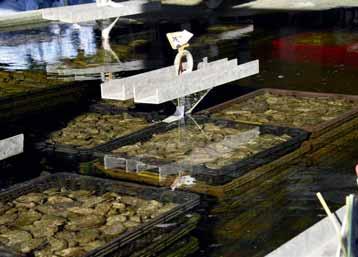
Volume: 2,000 tonnes per year
Markets: EU countries, China
Oysters are traditionally packaged in boxes made of thin strips of wood. The oysters are placed in depuration tanks for a minimum of 48 hours. The cost of depuration is insignificantcomparedtothedamagetoa producer’s reputation if the oysters are tainted.

The visit by a delegation from the Turkish Ministry of Agriculture and Forestry to oyster and mussel farms in France continued to a mussel farming company cultivating mussels on bouchots, a traditional method in Brittany.
Mussels can be cultivated in beds or on stakes. In France mussels produced on stakes are called bouchot mussels and Brittany is the second largest producer of these after Normandy. Cultivating mussels this way allows a higher density and the mussels are easier to harvest. In addition, they are less vulnerable to predators such as crabs, and they do not contain sand or grit as they are suspended in the water column and not lying on the seabed.
The Mont St-Michel bay is among the bays in Brittany where bouchot mussels are cultivated. The company Cap à l’Ouest is a member of a group of 43 farmers who all produce mussels. Lines of wooden stakes are arranged in the
bay extending from the direction of the shore out to sea. The tide in the bay is impressive as the water travels some 12 km each way so that the 6 m (of which 3 m are buried in sand) high stakes and the mussels they carry are exposed at low tide and almost submerged at high tide. In terms of height there is a 15 m difference between high and low tides, the second highest in the world after the Bay of Fundy in Canada. This movement of the water forces the mussels to open and close encouraging development of the mussel meat and improving its texture. Each tide lasts 12 hours so the mussels are covered by water for half a day and uncovered the other half.
The mussel growing cycle starts with the arrival in summer (May to July) of juvenile mussels attached to ropes. There is
no naturally occurring spat in the bay so producers have to buy the juveniles from hatcheries in south Brittany. If the juveniles are very small the ropes are placed in nurseries, special areas where the ropes are stretched horizontally in the water If they are a good size the rope will be attached to the bouchot directly. The mussels take 12-18 months to reach harvest size. As they grow the mussels are enclosed In nets to prevent them from detaching and to protect them from predators. The company tried using biodegradable
The Cap à l’Ouest bouchots are located at one end of the bay.
Mussels from the Mont St-Michel bay are certified to the EU’s Protected Designation of Origin (AOP in French).

Since the area is covered in more or less identical bouchots belonging to different companies, identifying the Cap à l’Ouest bouchots is impossible for a visitor. Company employees know the location and there are signs as well. A different method of telling one company’s bouchot from
 Bouchots carry the nets with the mussels. They are 6 m long altogether and are sunk 3 m deep into the sand.
Amphibious vehicles that can move on land and in the sea (though they cannot fly) have made the task of harvesting mussels much easier.
nets but found that they were not as good as plastic nets so they switched back to plastic nets.
Bouchots carry the nets with the mussels. They are 6 m long altogether and are sunk 3 m deep into the sand.
Amphibious vehicles that can move on land and in the sea (though they cannot fly) have made the task of harvesting mussels much easier.
nets but found that they were not as good as plastic nets so they switched back to plastic nets.
another’s is the way the nets with the mussels are wrapped around the bouchots. In former times the harvesting was manual. To harvest staff would walk out to the bouchots, harvest the mussels and return, a task that would take 12 hours. Today it Is much easier. Amphibious vehicles, boats with wheels, allow the workers to drive to the point where the water starts getting deeper and then switching to boat mode and sailing the rest of the trip. Instead of spending half a day to harvest, it can now be done in six hours. The boat Is equipped with a crane and several large tubs. When the pilot aligns the boat with the bouchots, the crane operator then removes the mussel-containing net from the bouchot and deposits it in a tub. Each bouchot takes about two minutes to harvest.
The mussels would normally be brought back to the factory to be washed, graded, and packed into bags. However, if there are no immediate buyers they are stored in boxes placed on frames at the start of the concession and will be collected the next day. The boxes will be under water when the tide comes in, so they will maintain their quality. The alternative is to take them back to the factory and place them in depuration tanks. Depuration is normally for a minimum of 12 hours, but if the water good quality with a high oxygen content the mussels can remain in
the depuration tanks for seven days or more.
After being harvested the mussels are brought back to the processing facility where they are washed and graded. Grading divides the mussels into three groups, the largest ones, over 5 cm, are branded Morisseau mussels, a premium product; between 4 and 5 cm the mussels are called bouchot, and those below 4 cm are returned to the sea to grow some more. Some 15 years ago Mr Hesry, the owner of the company, applied for the European protected designation of origin (PDO or AOP in French) label which indicates a strong link between the product and the place it is made. According to the PDO criteria each part of the production, processing, and preparation process must take place in the specific region. According to Mr Hesry, mussels from the Mont St-Michel bay are the only ones in France to sell under an AOP. The mussels are further classified by weight: Morisseau mussels are 100 pieces/kg, while AOP and bouchot mussels are 140 and 160 pieces respectively per kilo. These sizes are also reflected in the price, Morisseau, AOP, and bouchot mussels sell for 3.6, 3.0 and 2.4 euros/kg respectively. While at the retailer the price of the Morisseau mussel is 7 euros/kg.
The crane has an attachment specially developed to harvest the mussels from a bouchot. It takes a minute to remove up to 80 kg of mussels from a stake. A line of bouchots can be seen in the background.

Annual production at Cap à l’Ouest is about 700 tonnes but the mussels are only harvested from June to February. For the remaining months the company imports mussels from other European countries, primarily Ireland but also Jersey, Denmark, and Sweden. The product is sold all around France but is also exported to other European countries (Austria, Germany, Italy, Belgium). Fishmongers, wholesalers, and restaurants are the main buyers, and the product is only delivered in bulk in bags. We do not sell to retailers, Mr Hesry emphasises.
For the company 2022 has not been a good year, he says. Pollution in the water, predation by spider crabs, a lack of rain which
D797
35960 Le Vivier-sur-Mer
France

Tel.: +33 2 9948 8592
Owner: Mr Hesry
Activity: Cultivation and trade of mussels
Volumes produced annually: 700 tonnes
pushes up the salinity and means less nutrients which in turn affects production of the phytoplankton on which the mussels feed, all affected the yield negatively. Predation by spider crabs this year has been the worst we have seen in the last 25 years.

The Turkish delegation found the trip to the mussel farm interesting and useful. Whether the representatives’ visit will trigger the introduction of bouchots to Turkish waters remains to be seen. Other methods of cultivation such as suspending lines from rafts or longlines may be more appropriate for Turkish conditions, but the information gathered in France will have a role to play in the nascent Turkish mussel farming sector.
Brand: Morisseau
Certification: Protected
Designation of Origin (PDO)
Markets: France, Austria, Germany, Italy, Belgium, Singapore, Hong Kong
Product: Bulk packaged in bags
Customers: Fishmongers, wholesalers, restaurants
Employees: 27

A shellfish farmer in this part of north Brittany would like to do more for the environment with his mussel cultivation. But persuading his fellow farmers is not easy.
Shellfish farms are familyrun businesses in Brittany and Le Panier Iodé in Planguenoual is no exception. Anthony Juin, the current owner, is the third generation in his family to run the company his grandfather started in the 60s. When he took over in 2017 Mr Juin expanded into new activities including a shop and a restaurant, which offered ways to add more value to his product.
The mussels are farmed in a bay where the difference between high and low tides is 12 m. Rivers bring their load of nutrients to the bay so that the tides and the nutrients provide the conditions that mussels need to thrive. The nutrients encourage the growth of the phytoplankton on which the mussels feed, while the tidal movement
of the water forces the mussels to open and close. The farming of mussels is done the traditional way with posts (bouchot), but in other ways it has changed. In the past, Mr Juin says, the farmer had to go out to the posts with a horse and carriage to harvest, now boats are used. This development has also enabled the bouchots to be placed further out to sea.
At Le Panier Iodé the juvenile mussels are obtained from hatcheries in the south of Brittany and are placed in the water for 12-18 months before they are harvested. Although Mr Juin is permitted to place 180 posts in a line, he has opted to use only 140 to reduce the density and encourage the mussels to grow better. With 156 lines each 100 m in length annual production amounts to 800 tonnes on average. In 2022 predation and hot weather reduced the yield, however, to about 600 tonnes. Over the last few
Anthony Juin (right) the owner of the company Le Panier Iodé which is involved in mussel farming and in running a seafood restaurant and a shellfish shop. To the left is an employee who interpreted between French and English.
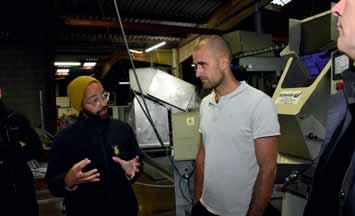
years the company’s focus shifted to quality over quantity and to diversification. Launching a shop and a restaurant would secure jobs even if bad weather or pollution reduced the production. For example, the Grade A classification of the production area became B last year following the release of pollution from a nearby camping site. The downgrade makes no difference to the product quality at all, Mr Juin hastens to add, because the bivalves are depurated in any case. But it illustrates that factors outside our control can sometimes affect the production.

The classification into Grades A, B, or C is determined by the
concentration of E. coli in the mussel flesh. Below 230 cfu (colony forming units) of E. coli per 100 g qualifies as Grade A and the mussels can be sold for direct human consumption. Below 4,600 cfu ranks as Grade B and the mussels must be depurated, relayed, or heat treated before being sold for human consumption. Below 46,000 cfu counts as Grade C and the mussels must be relayed for at least two months or heat treated before being put on the market. If the concentration exceeds 46,000 cfu the mussels cannot be harvested for human consumption. The producer may determine the time the mussels spend in depuration, but the state monitors the production taking samples frequently and checking the bacterial concentration. Depurating the mussels in tanks full of
clean sea water removes the sand and grit they may have picked up if the sea is rough. If a risk exists then the water undergoes treatment with ozone or ultraviolet light to purify it before it goes to the tanks. Toxic algae do not pose a threat in this area (north Brittany), Mr Juin says, though in southern Brittany toxic blooms occur occasionally.
Of the 14 producers in the bay, Mr Juin and another producer constitute the only two who would like to see some changes in the practice of mussel production. The introduction of bioplastics, for example. Currently the use of conventional plastics dominates mussel farming, because of the material’s resilience. We would like to use sustainable plastic but cannot risk it disintegrating before we harvest the mussels, states Mr Juin. Another way to greater sustainability involves lowering the density of the posts and placing them
further offshore, but we need to convince the other producers of the benefits of these ideas, he says. Reducing density should reduce mortality, and by moving them offshore they will spend a longer time in the water which fosters growth. Bouchot mussels produced in the area enjoy a reputation for their taste though they rarely measure more than 4-5 cm. If we can maintain the taste yet increase the size of the mussels by shifting the cultivation further into the water, we may be able to increase the price, Mr Juin thinks. His customers may disagree though. They include small businesses, restaurants, delicatessen shops, and wholesalers in Brittany. The latter distribute the product to other parts of France. Brittany attracts a lot of tourists in summer when the population can increase 10-fold, but after October there is no one left so sales dwindle to almost nothing leaving the shop and the restaurant to generate the income.
But the work continues in the winter months. Replacing the nets on the posts takes up a large part of the winter. Another task comprises washing off the organisms that grow on the mussel shells, repairing damaged or broken posts, and maintaining or servicing the equipment in the factory. Apart from carrying out these chores, staff also need rest to recover from the gruelling summer period and to prepare for the start of the next season. The
46 route de Jospinet Armor, Lamballe 22400 Planguenoual France


Tel.: +33 2 9632 7499 contact@lepanieriode.com lepanieriode.com
work is demanding and someone hoping to enter the mussel farming business must either possess the necessary academic qualifications or hold 280 hours of farming experience. Acquiring a concession however is very difficult as new concessions do not exist and old ones come on the market only rarely. Over the last years Mr Juin managed to acquire three concessions and so could expand his production but being a farmer from the area he keeps himself informed about developments in the sector and makes a note of sites that may come up for sale.
Owner: Anthony Juin
Activity: Mussel farming, seafood restaurant, shop selling seafood
Production: 800 tonnes
Employees: 15
Members of the Turkish delegation from the Ministry of Agriculture and Forestry that visited the oyster and mussel farms. From right, Altug Atalay, General Director, Fisheries and Aquaculture; Turgay Turkyilmaz , Deputy Director; Tanju Ozdemirden, Head of Aquaculture; Buket Yazicioglu, Secretary General, Suymerbir, an industry association.
Restrictions on gathering and on travelling during the pandemic generated new ways for people to work. Webinars instead of face-to-face conferences, and meetings on Zoom or Teams instead of in person. Some of these changes have persisted even after restrictions have been rolled back. Some oyster famers have noticed that business lunches are less common and online events are still popular.
In Cancale, an area across the bay from Mont St-Michel, oysters are cultivated in two ways, says Stephan Alleaume, an oyster farmer. The Pacific oyster, Crassostrea gigas, grows in net bags placed on tables, while further out to sea, the European flat oyster, Ostrea edulis, is cultivated on the sea bed. Oyster spat, however, comes not from the area, but either from south of the river Loire or from hatcheries. The oyster farming area comprises different zones radiating seawards from the coast. The zone closest to the shore holds the mussels from the beds or from the tables on their way to the processing facility. The movement of the tides permits access to the tables or to the beds only one week in two. During that week we harvest as much as possible, Mr Alleaume explains, and more than we can
store in the facility. The excess we store here until we need them. The oysters rejected in the facility that must go back to the sea to grow some more also spend some days in this zone until the tides allow their return to the tables or the sea bed. The area functions like a staging post for oysters on their way to the factory or back to the water.
Some 30-40 companies produce oysters in the bay. Other species cultivated include bouchot mussels and, in some area, grooved carpet shell clams, taking the number of species farmed to four. The activity is intense and as a result space to expand production is no longer available, says Mr Alleaume. In addition, the

feed in the bay must supply both the cultivated and the naturally occurring stocks of shellfish, so this also constrains expansion. The farmers can keep track of the phytoplankton by satellite so that they know its volume and the direction of travel. The phytoplankton circulates around the bay allowing the different shellfish species to feed. They feed on different varieties of phytoplankton so there is no competition between oysters and mussels, for example. The oyster beds’ location in the bay protects them from most storms, but strong northeast winds can damage them.
Total production in the bay amounts to 10,000 tonnes of mussels, 5,000 tonnes of Pacific oysters and 1,000 tonnes of flat oysters. Mr Alleaume’s contribution is 700-800 tonnes of oysters. Pacific oysters dominate
his production too—they have been cultivated for many years in contrast to the flat oysters, a new activity that started only five years ago. The first harvest of the flat oysters was in fact only last year. At this site Mr Alleaume plans to reach a production of 700 tonnes of Pacific and 100 tonnes of flat oysters, however he also owns beds in Normandy and two farms in Ireland, in the north and the south. Flat oysters usually take 3-4 years, sometimes 5 to reach market size, while Pacific oysters require 3 years occasionally 4. Global warming does not favour growth as the oysters use the winter period to rest and if the winters are shorter and warmer they will get less rest. Growth concentrates in spring and autumn, while spawning occurs in the summer. Creating the reproductive material calls for energy and in winter if the oysters fail to get
 The oyster growing area in Cancale has different zones—a temporary storage area, the farm, and the beds for the European flat oysters.
Oysters are grown in bags placed on tables which are submerged periodically by the tide. As the oysters grow some are removed from the bag to maintain the appropriate density.
The oyster growing area in Cancale has different zones—a temporary storage area, the farm, and the beds for the European flat oysters.
Oysters are grown in bags placed on tables which are submerged periodically by the tide. As the oysters grow some are removed from the bag to maintain the appropriate density.
the rest they need it affects the growth the following year.
Mr Alleaume harvests all the year round to supply his markets. Before covid he exported to some 70 countries which accounted for 90-95 of his sales by volume. The situation has not returned to its pre-covid status as some countries still restricted movement in 2022. Covid influenced sales within France as the French vacationed within the country creating more demand for oysters. As countries relaxed restrictions some of the practices
introduced by covid remained in place. Online meetings, for example, working from home, and fewer business lunches all tend to reduce the consumption of oysters, which are closely linked to conviviality. And someone who knows how to open them must also be among the guests at a private party. Mr Alleaume experienced a particular slump when the restaurant and hotel sector closed down. Even if people wanted to eat oysters they could not because they could not open them. He notices also changes in the demographic profile of those that are eating oysters today. The generation of people in their 40s and 50s lacks curiosity, he says. If oysters did not form part of their childhood many will not eat them today. Younger people, however, show more spirit. They will try something new without much hesitation. Raw food resonates with them, and oysters hold a special appeal as they are they only food in French gastronomy eaten alive.
Christmas heralds a very busy period when the company makes some 20 of its turnover. However, for smaller producers the season may account for 80 of their turnover. To meet the
demand Mr Alleaume has two teams grading the oysters in the weeks up to Christmas, so that as it draws nearer the workforce can concentrate on packaging. To meet the spike in demand the number of staff increases from 27 to 70 people and when demand peaks the team can shift 25-30 tonnes of oysters in a day. Because finding labour becomes more and more difficult—even to fill permanent positions— Mr Alleaume entices the temporary staff hired over Christmas with high wages. These will often return year after year knowing they can work for two weeks and earn a months wages. The arrangement suits Mr Alleaume too as people employed by him once are trained and are far more efficient than newbies.
In some countries, such as the US and Australia, the length of the shell determines the grade of the oyster, but In France as in most of Europe the weight defines the grade. Grades go from 0 to 5 with 5 the smallest. Grade 5 oysters go back to the sea to continue growing. Flat oyster grades go from 00000, 0000, 000 and so on to 5. Another dimension used to categorise oysters is the proportion of meat in relation to the shell. If under 8 the oyster is regular, from 9 to 10.5 is fin and over 10.5 is special. Meat content can even reach 20, says Mr Alleaume, if the oysters
grow in areas where there is an abundance of food. Even a high content of meat cannot disguise the large volume of shell that remains. Converting this into a resource would add another income stream to the business. Mr Alleaume collaborates therefore with several companies to try and recycle the shell into chicken feed, scrubbing soap, sunglasses, and crockery. Poultry farms cannot be found in his area though, so the shell must be transported elsewhere which adds to the costs particularly as it is heavy.
Mr Alleaume rents his farm site from the government, which lays down the rules governing its use. Inspectors from the marine department monitor the activities at the site and check that the farmers do not exceed the permitted number of oyster bags per hectare.
Mr Alleaume knows that increasing the density will reduce the yield, but some other farmers feel differently. Those who value quality struggle with those who believe in volumes, he says. An accredited laboratory monitors water quality and the costs of this service are covered partly by the government and partly by the farmers’ association. The association takes a fee from the farmers proportionate to the size of the farm. The fee goes towards surveys, research, new ways of growing, and also for handling the contact with government authorities. The association plays an important role but building or rebuilding markets is a task for the farmer.
35260 Cancale
France

Tel.: +33 2 9989 6999
https://www.ferme-marine.com/en/
Activity: Oyster farming; dissemination about oyster farming
Production: 800 tonnes per year
Species: Pacific oyster (700 t), European flat oyster (100 t)

Markets: EU and non-EU countries
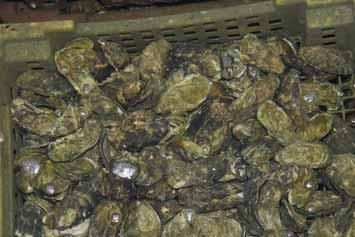 Before the oysters are sold they must be depurated to remove any sand or toxins.
A freshly opened oyster reveals its meat content. Oysters are the only food eaten live in France.
Before the oysters are sold they must be depurated to remove any sand or toxins.
A freshly opened oyster reveals its meat content. Oysters are the only food eaten live in France.

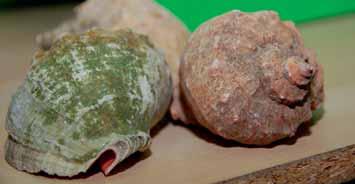
The veined rapa whelk (Rapana venosa), also called the Asian rapa whelk, is a predatory marine snail with an original range in the Indian Ocean and the Western Pacific up to the Sea of Japan. In recent decades, however, the species has been introduced by people to other regions worldwide and today is classed as one of the worst invasive species. Nevertheless, it has gained a certain economic significance in the Black Sea.
Its high ecological fitness makes Rapana venosa very successful as an invasive species. The snail tolerates a wide range of different salinities and temperatures, can tolerate lack of oxygen and water pollution, can use a variety of different foods, grows very quickly, becomes sexually mature early and is characterised by tremendous fertility. Its larvae can also vary the duration of their pelagic swarming period and are not too selective when choosing a place to settle on the sea floor at the onset of their metamorphosis The presence of all of these features together means that this predatory marine snail has permanently established itself and penetrated into many marine regions into which it was almost without exception introduced by humans. This has frequently led to undesirable consequences, since the spread of Rapana causes
profound changes in marine ecosystems in many locations In the Black Sea, for example, where this exotic intruder has long since become a widely distributed mollusc and an integral part of the sea floor bioceonosis
Rapana is smaller in the Black Sea due to the living conditions there, but otherwise does very well. While fully grown specimens in the Far East can reach snail shell lengths of up to 18 cm with weights up to 300 g, in the Black Sea these animals only reach two thirds of this size, at a length of 12 cm. The external appearance of the snails is however absolutely identical whether it is found in its original native marine region or in its newly conquered one. Rapana has a thick shell, a large body whorl as well as 6 or 7 right-turning spiral swirls on top of it. This creates a
conical, tapered basic shape that the genus name Rapana is also derived from (Lat. rapa – beet). Just as characteristic are the deep umbilicus, the ribs running in a spiral direction and axial fins on the shell as well as the egg-shaped oval shell opening with its thin external lips and fluted edge. In large specimens, there are often hollow teeth on the edges of the opening. A horny operculum closes the oval opening of the shell like a lid, protecting the soft snail body from predators and from drying out, for example if its environment becomes dry during ebb tides.
The typical colouration of the snail shell varies from matt grey to orange-brown, usually with more or less conspicuous brownish or blackish lines and flecks on the spiral ribs, which form a vein-like
pattern (hence the name “veined rapa whelk”).
In older animals, the surface of the shell can, however, be subject to shedding and erosion. The shell has a strongly coloured deep orange to cream yellow basic colouring in the opening Depending on the substrate, deviations in the body composition and colouration are possible. Populations on hard stone substrates have mainly darkcoloured shells, while population on bordering sand more often exhibit white or pale brown shells.
The original distribution area of Rapana venosa is in the Japanese, Yellow and Bohai Seas as well as in the East China Sea from Peter
the Great Bay off Vladivostok in the north to Taiwan in the south. From there, however, the species has been introduced almost worldwide to different European and American waters. It has spread particularly successfully in the Black Sea, where the first evidence for it was found in Novorossiysk Bay in Russia around 1947. It is generally suspected that snail larvae got here in the ballast water of ships, although introduction via oyster seed from the Pacific is also quite possible. Within just one decade, Rapana spread along the Caucasian and Crimean coast and up to the Azov Sea (1953) in the Black Sea. Then it penetrated via Bulgaria (first evidence found in 1955) and Romania (1961) to Turkish coastal areas (1959) and today can be found practically everywhere in the Black Sea on sandy and hard sea floor substrates up to 30 m depth. The lack of competition, rich range of food on offer and the enormous fertility of the invader were helpful in its rapid spread. It multiplied quickly even at low salinities around 18 parts per thousand. Rapana penetrated into the Mediterranean via the Sea of Marmara and was found in the Adriatic for the first time in 1974 before reaching Venice in 1983. Now the snail is present in abundance and well-established in the northern Adriatic. In 2002 it was also found off Mikhmoret Beach in Israel.
This was not the end of the expansion of this predatory snail, however, as it was spotted in Quiberon Bay off the French Atlantic coast for the first time in 1998. It is suspected that young snails were introduced as stowaways along with Japanese carpet shell (Ruditapes philippinarum) from the Adriatic. In the meantime, however, natural vectors for transport and spread were also found. In
Wassaw Sound (Georgia) off the East Coast of the US, juvenile Rapanas were found on sea turtles Currently there are five geographical regions worldwide outside of the natural distribution area of the species in Asia in which reproducing Rapana populations exist. These are, in addition to the Black Sea : the Adriatic and the Aegean, Chesapeake Bay in the North West Atlantic, the estuary of the Rio do la Plata in the South West Atlantic and the Bretagne coast in France in the North East Atlantic. Occasionally, however, individual animals are found in other areas, such as the Pacific coast of Canada and in Willapa Bay, Washington, USA , in the North Sea between the UK and the Netherlands as well as in Ría de Arousa, Spain. Genetic comparisons of Asian, Black Sea, Mediterranean, Atlantic-European and Chesapeake specimens show that all Atlantic populations of snails originally come from the Black Sea.
Rapana is a habitat generalist that can live in the subtidal water area on both sandy and rocky substrates at depths between 0.5 to around 30 m. Sandy sea floors are preferred, because the snails, which are primarily active at night, can almost completely bury themselves in the sand during the day, with only their siphon for respiratory water protruding above the sand. Just as unusual as their tolerance of a wide range of temperatures from 4 to 27°C (some authors even claim 35°C) is their tolerance for low salt contents, down to approximately 12 parts per thousand (apparently these animals can even survive for a few days at 9 parts per thousand). There is also a significant resistance to lack of oxygen (hypoxia) extending to 1.4 mg O2/l. At such low values, almost all shellfish that are part of the staple diet of the Rapana, are incapacitated.
A highly predatory animal that is responsible for significant changes in the ecology of many parts of the Black Sea, rapana is also a resource that is harvested and consumed either locally or shipped abroad.

When it comes to food, a distinction must of course be made between the individual life stages of these predatory snails The swarming veliger larvae that swim in the open water feed exclusively on plankton organisms and detritus, i.e. flagellates, diatoms and other organic particles. Upon their metamorphosis and their transition into a benthic way of life, their food spectrum changes and the young snails feed on thinwalled shellfish, oyster spat and young oysters To get to the flesh of their shellfish prey, the young snails scrape a hole in the shells with their toothed grating tongue (radula). From a size of about 35 mm, the predatory marine snails change their feeding style once again. Now they dispense with the time-consuming scraping and place their muscular foot over their prey to suffocate it. When the sphincter muscle of the shellfish goes limp, the snail opens the shell and pushes its proboscis into the soft innards in order to consume the nutritious contents Incidentally, this strategy does not make it easy for researchers to correctly estimate the extent of feeding damage caused by Rapana to shellfish cultures and beds, because the shells remain
intact and do not have any holes in them. If available, Rapana will also feed on carrion, such as dead fish or crabs on the sea floor.
Rapana has hardly any predators of its own In its native region of origin, the species is mainly depleted by starfish, but these are not present in the nine bodies of water it has settled in In Chesapeake Bay, blue crabs (Callinectes sapidus) at least eat the smaller snails ; however, this does not seriously endanger this invasive snail species. Therefore, the most important factor in regulating stocks is man, who influences the number and spread of the snails both intentionally and unintentionally. The use of tributyltin (TBT) in antifouling paints, for example, negatively affects the fertility of Rapana (causing imposex) and therefore has an indirect regulating effect
Rapana is unisexual and fertilisation occurs internally. The animals usually reproduce in their first year at minimum lengths of 35 to 50 mm. In their native distribution area, they lay eggs from April to the end of July at temperatures of 13 to 26°C. In the Black Sea their
reproduction time is somewhat later, from July to September (temperature window 19 to 25°C). Their clutches are comprised of numerous egg capsules that are around 9 to 40 mm high and 3 mm wide and taper to a broad, leaf-shaped tip. At the tip, the capsules end in a pore, through which the larvae leave the case after hatching Each of these capsules can contain 200 to 1,000 eggs The clutch, which is attached to the solid substrate, consists of a few dozen to 600 capsules (the average number in the Black Sea is 84). After the eggs are laid, the capsules are initially whitish, yellow or pale violet in colour. However they become increasingly grey over time and eventually black when the larvae are ready to hatch. The veliger larvae, which are around 1.3 mm long and 0.3 to 0.4 mm wide, usually leave the protective capsules after 12 to 17 days through the pores at the tip of the capsule and then swim using their doublelobed velum for nearly three weeks (at 25–29°C) among the plankton in order to find a suitable living space to settle on the sea floor. The enormous biological plasticity of these snails is also shown by the duration of their planktonic phase, which in some cases can extend to 80 days after hatching
The metamorphosis then occurs on the sea floor. This is defined by the loss of the larval velum, the organ responsible for swimming, gaseous exchange and the intake of plankton food. After their metamorphosis, the individuals grow more than a millimetre per week and can reach shell lengths of 40 to 50 mm in five months and over 60 mm after one year. Even the small snails feed as predators The length of their shell is a good 1 mm at the time of their metamorphosis (Rapana venosa). The lifelong fertility of this predatory snail is very high, since Rapana can live for up to 15 years. Both the size of the capsules
and the number of eggs increase with the size of the females, as does fertility. Young snails of 35 mm in length lay on average twice per year, laying 100,000 eggs each time. Older animals with 160 mm or more shell length produce up to four clutches every year, each with 1,000,000 eggs
Despite the high mortality rates of the larvae, given these enormous fertility figures, it is understandable that the uncontrolled, invasive spread of Rapana means serious ecological consequences for many native species. Bivalves such as blue mussels, oysters, scallops, cockles and clams (Maierhofer gallina), inequivalve ark (Anadara inaequivalvis) and the Japanese littleneck clam (Venerupis philippinarum), and also some limpets and barnacles (Amphibalanus improvisus). In the Black Sea, where there are no natural predators of Rapana, this feeding opportunist has caused significant changes to shellfish banks that are seriously negatively affecting shellfish fishing Attempts to eradicate Rapana venosa off the Bulgarian coast were unsuccessful.
However, the arrival of the snails also has an economic upside, as Rapana is an esteemed delicacy in some Asian countries, particularly Japan and South Korea For this reason, export-oriented Rapana fisheries with dredges, beam trawls and divers have developed in the Black Sea, particularly in Turkey and Bulgaria. In Turkey alone, almost 800 boats were licensed for Rapana fishing in 2018. According to TURKSTAT (2020) the usually small snail fishing operations generated revenue of USD 5.7 million in 2019. Almost 5,000 people are employed in fishing, processing
and marketing Rapana has therefore achieved a certain economic importance, in particular for smallscale artisanal fishing operations. Since there are signs of regional overexploitation, some countries have even introduced protective measures. In Turkey a licence is required for fishing that is issued by the Ministry for Agriculture and Forestry and there are size restrictions for catches To prevent damage being caused by dredging in benthic habitats, more sustainable catch methods are currently being tried in Turkey. Attempts involving baited traps similar to lobster pots are particularly promising These involve limited bycatch and enable better control of Rapana catches. A management model for all Black Sea countries is also currently being considered.
Their nutritional value and decorative snail shells make Rapana a valuable biological resource in the Black Sea. In Turkey alone, the annual harvest is approximately 1,000 tonnes of meat only, of which more than two-thirds has been exported to Asia since early 2000s. In the meantime, the muscular foot of this mollusc has also become an in-demand product in many restaurants on the Black Sea coast. Demand has significantly increased since the animals have been marketed with the claim that Rapana meat has aphrodisiac properties.
The attractive shape of the snail shell with its intense orangecoloured interior makes Rapana a popular product with souvenir retailers Craftspeople make a variety of jewellery and decorative products from the shells In addition, the spread of the marine snails in the Black Sea has also had an interesting side-effect for at least one species from the animal world there. The shells of Rapana are used by the hermit crab Diogenes
pugilator as a house. Earlier, prior to the introduction of Rapana, these crabs usually hid their soft and fragile rear ends in shells of the netted dog whelk Nassarius reticulatus, which however reaches significantly smaller sizes of around 3 cm. This necessarily limited the size of the crabs, because it was much too dangerous to become bigger than their available accommodation in which they can hide in case of danger. Today, however, biologists are observing that the Diogenes hermit crab is becoming significantly larger than before. Because Rapana shells are significantly more spacious, even large, sizeable crabs can always find suitable housing
The question of whether the arrival of foreign and invasive species such as Rapana is more of an advantage or a disadvantage can hardly be answered in a general sense. It is really a moot point anyway, because there is no real room for action and all attempts to combat the species, i.e. to get rid of it, have been unsuccessful to date. Under these conditions, commercial fishing is one of the few options available to somewhat limit the spread of the species and to exploit its economic potential. In Chesapeake Bay off the coast of the US, attempts are being made to push back the Rapana through a comprehensive public information programme. This is an attempt to increase public awareness of the risks associated with the Rapana invasions. A reward is being paid for specimens delivered to the Virginia Institute of Marine Science. There are guidelines on how to correctly destroy any clutches and snail eggs found. Whether these measures and the public information programme will finally be enough to effectively stem the damaging effects of these invaders on native marine ecosystems, however, remains doubtful.
Manfred Klinkhardt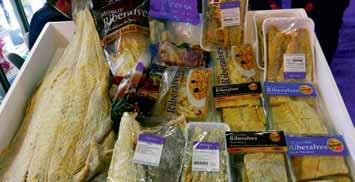
Packaging requirements for food, but above all for fish and seafood, are particularly demanding. Packaging needs to protect its perishable contents from spoiling and external influences while being as inexpensive as possible. Plastic packaging meets this requirements profile particularly well. But we wish to replace it with other materials because it is not sustainable. How realistic is this?
Plastic was once viewed as the ideal solution for many packaging problems. The material is light, offers endless design possibilities, is food-safe and is also relatively inexpensive. But the shocking extent of plastic waste in the seas has brought plastic into disrepute and made it the focus of public attention. Industrial and retail companies have recognised the problem and are looking for more environmentally friendly, sustainable packaging materials. But for fish in particular it is very difficult to replace traditional plastic packaging with materials with similarly good properties. Plastic packaging for fish and seafood products has been tried and tested over many years. It is safe, hygienic and taste and odour-neutral, which is particularly advantageous for moist fish products. A plastic covering also protects its contents from premature spoiling. It shields the product from negative external influences such as microorganisms, oxygen, light and mechanical stresses and often even expands and reshapes, which makes manufacturing temperature-insulating, salt and acid resistant containers and shipping boxes possible. Plastic containers, trays, wraps or bags are versatile and suitable for almost every application. Despite all of the justified criticism, plastic is simply optimally suitable for packaging purposes.
Packaging is usually designed for single use and as such it is an example of the convenience-based lifestyle in our modern throwaway society. As soon as its contents have been removed, it has fulfilled its purpose and becomes waste. Therefore anyone wanting to act sustainably must first change their lifestyle. Some problems would completely cease to exist if all consumers properly disposed of plastic packaging as soon as the products it contained were removed. And not just now and again, but every time, and also everywhere in the world. A pipe dream, as we know, since for one thing, many places lack functioning disposal options for recycling used plastic. And for another, many people are not at all as environmentally aware as they frequently claim themselves to be. Much packaging is carelessly thrown away after use, pollutes the natural world and then unfortunately often ends up in the sea. For this reason, the manufacturers and providers of products packaged in plastic are under pressure worldwide to find more environmentally friendly packaging materials.
The variety of packaging materials makes the search more difficult
Despite some ideas and progress in some areas, there is currently no prospect of a material that could replace plastic packaging completely in the near future.
Sustainability is well-known not to be a short-term task, but rather an ongoing, continuous process that requires strategically oriented, wise action. Especially since the alternative materials must replace all traditional product coverings, i.e. wraps, boxes or insulating polystyrene cool boxes, for the storage, transport and retailing of fish products as well as for the takeaway business and online retail. And in addition to the actual packaging, this also includes other products such as strapping and adhesive bands or gel-filled cold packs and pads. Manufacturers, catering businesses and fish retailers must move away from tried and tested packaging practices and find new ways to continue to supply customers with products of the desired freshness and quality. The transition to recyclable, compostable or biodegradable packaging is a real challenge, especially since the costs for such
materials are 30 to 50 percent higher on average. If these additional costs were passed on to the retail price in full, however, this could appreciably reduce the willingness of many consumers to buy the products.
Some plastic packaging can already be replaced by alternative materials, but their sustainability is also sometimes viewed critically by experts. If all MAP trays and folding cartons, wraps, delicatessen bowls, blister packs and polystyrene cartons made from plastic were completely replaced with containers made from glass, paper, tin cans or cardboard, this would more than double energy consumption. Glass, for example, is very suitable for recycling, but is highly energy-intensive to manufacture. Glass is also significantly heavier than plastic, which results in higher transport costs. It is also prone to breaking and is thus
associated with certain risks when it comes to packaging food. Packaging manufacturers therefore face the challenge of developing completely new designs that meet hygiene, safety and labelling standards, guarantee the integrity and intactness of the packaged products, require less material if possible, and result in fewer greenhouse gas emissions associated with their manufacture. This requirements profile makes it clear that the development of more environmentally friendly and sustainable packaging requires new ideas and significant expertise.
Despite all of their problems and their poor image, thermoplastics will continue to play a very central role in the packaging sector for the foreseeable future. They simply offer too many advantages to be completely replaced yet. Nevertheless, there are some changes on the way in the use of plastic packaging which can be briefly expressed by the terms less, simpler and different. ‚Less‘ refers to the quantity of the plastic material
used. Wherever possible, plastic is avoided (for example in viewing windows in cardboard packaging) and material saved, for example by rolling out plastic wrap more thinly or shaping thermoformed trays differently and designing them to be lighter. ‚Simpler‘ primarily means that the composition of the plastic packaging is significantly changed. Instead of standard wraps and trays that are often composed of several layers, which makes recycling them significantly more difficult or even impossible, monomaterials are increasingly preferred, which can re-enter the materials cycle after use much more easily. And ‚different‘ refers in particular to the type of plastic material used, that preserves the usefulness of the packaging, but also offers specific advantages, for example the incorporation of recycled plastics or of plastic based on natural raw materials.
Vacuum skin packaging, where the covering film wraps around the packaged product like a second skin, is a great example of these innovative packaging strategies that aim to be less, simpler and different. Recently it has increasingly also been used in retailing fish

and seafood products. With skin packaging, film use is significantly reduced and mono APET films can also be used (APET stands for amorphous polyethylene terephthalate), more than two-thirds of which are composed of recyclate (chemically recycled plastic). The term ‚simpler‘ must therefore be qualified somewhat, since manufacturing these special films with defined shrink properties is of course an advanced technology. Skin packaging offers enormous advantages both for the manufacturer and for customers. The use of material and therefore the quantity of packaging waste saved is significantly reduced and customers can see the whole product. Integrated easy-peel corners also often make opening the packaging and removing the contents easier.
Returning supposed plastic waste to the proper materials cycle is a model that is favoured by many in the packaging industry. Packaging made from recycled polyethylene terephthalate (rPET), a breakproof plastic that can be reused up to 25 times, also has a positive ecological balance due to its low transport weight. Recycled PET, which is used, among other things, for vacuum bags, MAP trays and other packaging, saves natural resources, protects the environment and contributes to reducing CO2 emissions. Traditional plastics therefore should not be prematurely written off. This also applies to expanded foamed polystyrene (EPS), from which heat-insulating polystyrene boxes are usually manufactured for the transport of fresh fish. These boxes are often already made from recycled polystyrene, without the performance characteristics of the packaging being in any way affected by this. Insulating boxes made from recy-
cled EPS, usually called ‚Ccycled polystyrene‘ for short, are even suitable as primary packaging for fish. Ccycled boxes have “likenew” quality and are approved for direct contact with food.
Significant hopes are now resting on bioplastics, which are seen as particularly environmentally friendly, because they cause significantly less greenhouse gas emissions than standard plastic material. A study carried out in 2017 calculated that the switch from conventional plastic to bioplastic based on corn would reduce the USA’s greenhouse gas emissions by 25 percent. According to estimates, the global market for bioplastics is currently approaching 44 billion US dollars. Bioplastics for packaging in the food sector are usually made from polylactic acid (PLA) which is typically obtained from the sugars in corn starch, manioc or sugar cane. PLA looks like and has the same properties as polyethylene (PE) but is biodegradable, climate-neutral and often even edible. Other biodegradable plastics are made from polyhydroxyalkanoates (PHAs) that are created from organic raw materials by microorganisms that are often genetically modified. However, PHA plastics are only rarely used for single-use food packaging. Because they are particularly biocompatible, they are more often used in the medical sector, such as for suture material after operations, as artificial bone plates and for skin replacements. What makes the use of bioplastics in the area of packaging difficult at the moment is their higher prices. They are on average 20 to 50 percent more expensive than comparable conventional plastics. Prices do have a tendency to fall, because more efficient methods for producing bioplastics are being developed, but only slowly.
A study from the University of Pittsburgh from 2010 also cast doubt on the environmental friendliness of bioplastics. The cultivation of corn, manioc, sugar cane and other plants that serve as the basic raw materials for biodegradable plastics is claimed to lead to increased land use, require greater water and energy consumption than conventional plastics, increase the use of fertilisers and pesticides and also contribute to higher greenhouse gas emissions. The Plastic Pollution Coalition assumes that currently, an area of arable land greater than Belgium, the Netherlands and Denmark together would be required to meet the global demand for bioplastics. This is currently lacking for the cultivation of food. In addition, bioplastics – contrary to generally held assumptions – are not industrially compostable. Biodegradable plastics will 90 decompose at 60 degrees after a maximum of 12 weeks. Despite all of these restrictions and doubts, teams of researchers across the world are looking for new ways to make the production of bioplastics more efficient and cost-effective. At Michigan State University, experiments are being carried out with cyanobacteria (blue algae) which create chemical bonds using photosynthesis. The California startup Mango Materials is working on eventually being able to convert methane gas from sewage treatment plants or landfill sites into bioplastic. Researchers from the Centre for Sustainable Technologies at the University of Bath in Britain claim to have already found a cheaper way to make polycarbonate out of sugar and carbon dioxide.
Fish processors and retailers are not just ready in principle, but often actually have a keen interest in exploiting innovative packaging concepts. Doing without plastic would be somewhat easier, however, if the available alternatives were equivalent or at least had similar properties to previously used packaging. Finally, it is not just the avoidance of waste that needs to be taken into account, but also transport and logistics, product safety, hygiene and attractive product presentation.
Not every innovative packaging idea is actually mature and supermarket-ready. Some concepts that superficially appear to be quite acceptable have not yet been able to be implemented as hoped. These include packaging materials made from agar from red seaweeds, and edible and biodegradable wraps made from the milk protein casein or from the mycelium of fungi. Bioplastics made from wood biomass, energy grasses and crop residues, as well as lignin or cellulose, have barely passed the testing stage. Now and again disposable dishes and packaging made from bamboo can be found on the market, but critics doubt their sustainability, because many of these products are to a large extent composed of synthetic plastics.
There are already environmentally friendly alternatives to polystyrene crates made from foamed plastic, namely reusable boxes and transport crates that are made of over 95 percent cardboard and can therefore simply be disposed of in the paper recyclables bin. Both fresh fillets and frozen products, for example, can be packed in folding cartons that can withstand even cold and damp conditions with
a wafer-thin PE coating. Another interesting option is dimensionally stable and environmentally friendly packaging made from paper injection moulding. This is made solely from paper fibres, water and industrial starch and exposed to heat by baking and is therefore particularly environmentally friendly. Paper can be processed, coated and printed into very different products or folded into complex packagings with the help of complicated folding techniques similar to Japanese origami. The purpose of use is crucial for selecting the right material. Corrugated cardboard, for example, is light, dimensionally stable, has a long lifespan and also has very good insulating properties. Many of these features are also true of solid cardboard, but with the limitation that it has a lower insulating value, which makes solid cardboard boxes the ideal packaging for the energy-saving freezing and frozen storage of fish. Products in a solid cardboard box freeze about 35 faster.
Environmentally friendly packaging made from paper and cardboard is gaining in importance in the growing takeaway business as well. Snack boxes, moulded trays and boxes with folding lids have similarly good performance characteristics as previous packaging made from aluminium or plastic,

and are therefore a sustainable alternative for burgers, baguettes, burritos or wraps. Even for challenging takeaway dishes, suitable paper boxes are now available. They usually have separate sections for the individual components, such as fish, sauce and sides, and can often even be reheated in the microwave if needed. After use, they can then simply be returned to the paper cycle via the paper recycling bin. However, even the use of paper in the area of packaging is now no longer completely uncontroversial, because the cellulose required often leads to the deforestation of entire forests, which are well-known to play an important role in climate protection. For this reason, packaging manufacturers are searching for suitable materials in this area as well, and they have hit on the composite cup plant (Silphium perfoliatum), among others. Sustainable papers and cardboards can be made from this plant species, which is native to North America, and is already being used for packaging perishable fish products such as hot smoked salmon. Cup plant paper is resource-efficient. Relatively little water and energy are required for the preparation process and the fibres are obtained without harmful chemicals. Its regional cultivation also shortens transport routes and reduces associated CO2 emissions.
Manfred KlinkhardtJarek Zielinski has been involved with the advisory councils for the last 17 years and was party to the founding of several of them. This experience will help him in his newish role as chair of the Baltic Sea Advisory Council’s executive committee, where he will have to try and formulate recommendations for the European Commission that are supported by both wings of the advisory council, the fishers and the NGOs.
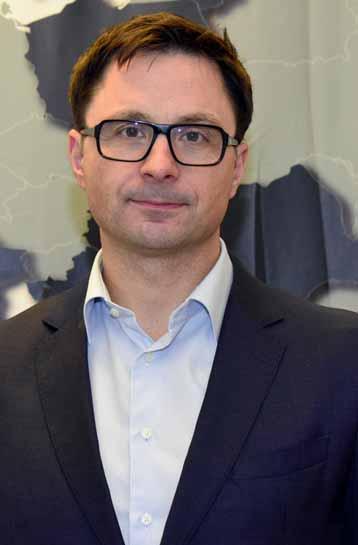
You have recently been elected chairman of the Baltic Sea Advisory Council. What made you seek the position and what plans do you have for the organisation? What do you hope to achieve during your tenure?
Not so recently…time flies and it’s been already eight months since I was elected. In fact I was approached by other members of the BSAC, who seemed to note my experience and practical expertise in the EU fisheries sector and regional advisory councils. Although I am involved with the BSAC since 2020, as the representative of the Polish Fish Producers Organization Bałtyk, from Kołobrzeg, my experience in this field goes back to 2006. I was involved, as the representative of the Polish fishing industry in the process of establishing the North Sea AC, Pelagic AC, and Long Distance Fishery AC.
Now, to answer your question I need to present the context. The view of the BSAC from the chair’s perspective was that in eighteen years of activity the BSAC is largely fulfilling its role as an advisory council by providing the Commission and the Member
States with relevant input from regional stakeholders in relation to the management of the Baltic Sea fisheries. There is value created and potential in this organization which is in fact very divided. However, there is also a frustration, across the stakeholder groups, especially about lack of impact of the BSAC advice and recommendation at EU level. This is demotivating and some members declare that they consider leaving.
In 2020 the BSAC Executive Committee ordered an evaluation of the BSAC. Data in the evaluation is based on a survey distributed to the member organizations and also to observers. Delivered in 2021 the report presents an interesting overview of this organization and its members. It also contains recommendations to improve the work and organization of the BSAC. It is clear, that there is a potential for elevating the impact of the BSAC, by finding common ground, being proactive and aligning with policy makers. There is also a need for improvements; most notably in facilitating trust and cooperation between BSAC members.
So, I have clear recommendations for improvements in the organization requested by the members. Increased dissemination of BSAC recommendations and ultimately the efficiency of the advice, fostering member engagement are the starting point. Members also expect the BSAC not only to tackle core topics such as advice on fish stocks and fishing opportunities. They bring up additional sensitive topics like species interaction, seals and cormorants’ impact on the environment, and new issues such as offshore wind farm development in the Baltic Sea, impact of climate change on fisheries, and socio-economic impact of all of these. The members set these goals. A relevant topic, which I also keep in mind, is how to better integrate the small-scale fisheries representatives.
Today, this organization does not need a visionary but an efficient, creative and proactive officer who will efficiently maintain the discussion and implement these recommendations based on what is important, not only the suggestions of professional evaluators, but most of all the suggestions and ideas of the BSAC members. And so here I am—with my background and practical experience in project management. I am motivated by the fact that I was unanimously elected by all members of the BSAC, and that cooperation within the management team is based on respect. The combination of enthusiasm and experience offered by the new BSAC Secretary General Guillaume Carruel and Rapporteur Ewa Milewska also gave me a boost.
The BSAC executive committee comprises representatives from the fishing sector who are in the majority and representatives from NGOs. The two groups have starkly differing attitudes
with regard to certain issues. How do you ensure that the majority does not steamroller the environmental groups and that NGO viewpoints are adequately represented in BSAC recommendations?
There are rules to be followed: all Advisory Councils follow the socalled Basic Regulation by striving to reach consensus in their advice. The BSAC is no different and always aims at finding consensus that is reflected in the recommendations. One might say that half of the job is done already; there is legislation to follow. Special attention has been devoted recently in the BSAC to this issue which is relevant for the process of producing the advice and crucial for the quality of the advice. The problem has been evaluated and recommendations for improvement listed. Now it is about implementing them. This is a process though and we work on this. People want to help in improving their organization. This is great value. I am happy about this.
The BSAC also has its own Rules of Procedure to guarantee a fair consultation process for all members. These rules are simple and clear for everyone. One of the first steps taken last year was to launch a focus group on the revision of the Rules of Procedures. This revision is needed to be in line with the latest EU regulation and at the same time also aims to answer some concerns raised by members and to ensure continued working in a fair, transparent and efficient way. Together with me, from the industry, the Executive Committee Vice-Chair and the Ecosystem Based Management Working Group Chair have been elected. Both are from the Other Interest Group and are members of the Management Team. I highly appreciate their
engagement which is a great support for me and the Secretary. BSAC has also additional special tools, in use, to help small scale fisheries representatives to attend the meetings and discussion. We have also some new ideas for this, but we have to fit them in the budget which might be reduced by the Commission. We’ll see. Regarding the budget— a review of the finances, and their optimisation, was one of first steps I took upon my election.
The collapse of cod stocks in the Baltic has resulted in some Baltic fishers concentrating on pelagic species, sprat and herring, while others have decommissioned their vessels and pulled out the profession. What long term effects on Baltic fishing fleets do you envisage from the decline in cod fishing opportunities?
Now we touch upon topics, where, as the advisory council ExCom chair I have to stick to the rule of being impartial, so let me now share the outcome of the discussions within the BSAC. There is a systematic reduction in productivity of the whole Baltic ecosystem, due to factors besides fishing. There may be a need for further adaptation of fishing capacity and the whole structure of the sector.
This is a relevant and difficult issue, taking into account the socio-economic consequences of the current environmental situation in the Baltic.
The decline in fishing opportunities especially for cod, salmon, and eel but also for pelagic species has had a tremendous effect on fishing fleets, fishers, and communities depending on these emblematic species. It is escalating, especially in the case of the small coastal
fishing fleet. The fisheries sector all around the Baltic has been faced with a decision on how to restructure in order to adapt to this situation. The situation is even more complicated for those fleets and fleet segments which have no alternative for fishing outside the Baltic Sea. Of course, permanent cessation is one of the directions.
The ecosystem changes have in turn triggered shifts in the target species. Pelagic species have taken a prominent place both in landing volumes and value. But, in the long term, increasing the number of vessels and fishing effort on the pelagic stocks does not seem to be the right way, neither environmentally nor economically. Stickleback may also play a role in the future of fisheries in the Baltic. Trial fisheries are ongoing in most countries to gain more knowledge on the stock to assess its potential as a new sustainable fishery. Fishers have also renewed their focus on coastal stocks and species with healthy stocks such as flatfish (plaice). New gears are being developed and these new developments need to be supported.
There is a need for a more substantial reflection on socioeconomic aspects and other kinds of aid to convert or adapt the sector. Further discussion is needed on subsidies in the context of fishing capacity, engines, and selectivity. The BSAC finds it important to initiate and support the development of new fisheries and fishing methods that meet the need for a selective and optimised fishery. The restoration and conservation of habitats, species, water quality and migration routes also deserve public funding. The fact that there are subsidies which bring the desired target closer should be acknowledged. This reflection
should also consider that socioeconomic consequences affect not only fishing industry and fishing societies, but also local fish processors, fish traders, etc.
Several factors are considered to have contributed to the collapse of cod stocks in the Baltic many of which are anthropogenic including fishing pressure, pollution, and habitat destruction. How does the Baltic AC contribute to addressing these issues which could help revive the stocks?
The BSAC’s role is to advise the European Commission and Member States on matters relating to the management of fisheries and the socioeconomic and conservation aspects of fisheries. In that sense, the BSAC annual recommendations on TACs advise on how to adapt fishing pressure to the current state of the stocks while considering socio-economic aspects. In previous years, specific recommendations on the cod stocks have been published.
There needs to be a clear link between setting priorities in fisheries management and analysing the social and economic consequences of decisions taken. The ensuing costs are both economic and social, and these need to be clearly described, accounted for, and included in management decisions. The transparent implementation of Article 17 of the Basic Regulation1 and funding from the European Maritime Fisheries and Aquaculture Fund (EMFAF)2 can contribute to the social dimension of fisheries management. In this connection,
Producer Organisations also play an important role.
The BSAC closely follows research on the interspecies mechanisms that play an important role in the actual state of the Baltic fish stocks. Interrelations between herring and sprat, predation by cormorants and seals, and seal parasites found commonly in cod are studied by researchers around the Baltic. Experts are regularly invited to BSAC meetings to give presentations as we need to understand better what is at play, and to conclude the advice. The Council continues to underline that fisheries management and science should focus on the overall ecosystem, as well as other factors that are affecting the well-being of certain stocks. Ecosystem, multi-species considerations and food-web interactions must be taken into account in the overall policy orientations. More should be done to provide clearer scientific explanations and input to managers on these mechanisms. ICES and national scientific maritime institutes play a major role here.
Remote electronic monitoring (REM -- cameras onboard fishing vessels) is being piloted in different European countries. Fishermen tend to find it intrusive but with the right incentives some are accepting the technology. What is the feeling in the BSAC about REM? Do you feel REM could have a role to play in monitoring Baltic fishing vessels?
The BSAC discussed REM and the use of CCTV extensively, at
several occasions in 2018-20192020 in the wake of the revision of the Control Regulation. Views are quite divided within the members. Fisheries representatives generally support an increase in control by using the tools currently available. They point to the additional burden, implementation issues, and risks of the mandatory use of CCTV. And CCTV systems will be more difficult to use on smaller boats. Some representatives of the OIG support control of the landing obligation by means of CCTV. In case CCTV systems become obligatory, the BSAC notes the need for detailed discussions related to technical and financial side.
The BSAC agrees to privacy concerns related to the use of CCTV systems.
Generally, the BSAC recognises that control and surveillance are of great importance regarding management of the Baltic stocks. The level of control has an obvious impact on the management of the Baltic stocks. This was demonstrated clearly in October 2022, when during the presentation of the Commission’s proposal for the Baltic stocks TACs, for 2023, to the PECH Committee, the Commission explained that problems with control of the landing obligation were factored in the TAC proposals. As result quite a number of TACs were proposed at MSY lower range.
The stakeholders in the Baltic are rising to this challenge and many projects have been initiated and are ongoing to boost transparency and surveillance. For instance, some pelagic fisheries are experimenting on a voluntary
basis with fully documented fishing and large scale remote electronic monitoring projects including CCTV on their vessels.
During the joint EFCA-BALTFISH-BSAC workshop held in March 2022, EFCA recognised that compliance with the landing obligation in period 2019-2021 is higher than in the past. Still, the EFCA Baltic Sea Steering Group acknowledged the need for improvement. BSAC has been cooperating actively with EFCA for a number of years and in 2023, cooperation between EFCA and the BSAC will be very close.
You are keen to increase the cooperation between the BSAC and Eurofish. While many countries represented in the BSAC are also members of Eurofish, which areas of interest to the BSAC do you feel Eurofish may be able to contribute to?
Cooperation with Eurofish and its members is paramount. I believe that reaching out to the readers of the magazine, and to the member countries of Eurofish, is key for BSAC recommendation and work to inform all stakeholders, administrations, and also potential future members of BSAC. In 2023-2024, the BSAC will continue advising on important issues, from fishing opportunities to offshore wind development, but we will also hold workshops on control or the role of predators in the ecosystem with BALTFISH and the European Fisheries Control Agency. Coverage of these events in the Eurofish Magazine may be of outmost importance.
1 Article 17 of the Basic Regulation: When allocating the fishing opportunities available to them, as referred to in Article 16, Member States shall use transparent and objective criteria including those of an environmental, social and economic nature. The criteria to be used may include, inter alia, the impact of fishing on the environment, the history of compliance, the contribution to the local economy and historic catch levels. Within the fishing opportunities allocated to them, Member States shall endeavour to provide incentives to fishing vessels deploying selective fishing gear or using fishing techniques with reduced environmental impact, such as reduced energy consumption or habitat damage.
2 https://eur-lex.europa.eu/legal-content/EN/TXT/?uri=uriserv:OJ.L_.2021.247.01.0001.01.ENG
15-16 February 2023
AquaFarm Pordenone, Italy Tel.: +39 0434 232 111 pdeodorico@fierapordenone.it https://www.aquafarm.show/en/
7-9 March 2023
North Atlantic Seafood Forum
Bergen, Norway Tel.: +47 481 14 196 andre@nor-seafood.no https://nor-seafood.com/
28-30 March 2023
Aqafuture Spain
Silleda, Spain Tel.: +34 620 681 861 okeventos.juan@gmail.com https://en.aquafuturespain.com/
29 May - 1 June 2023
World Aquaculture 2023 Darwin, Australia mario@marevent.com https://www.was.org/meeting/code/WA2023
22-24 August 2023
Aqua Nor Trondheim, Norway Tel.: +47 73 56 86 40 post@nor-fishing.no https://aquanor.no/en/
18-21 September 2023
Aquaculture Europe
Vienna, Austria mario@marevent.com www.aquaeas.org
3-5 October 2023
Conxemar Vigo, Spain
Tel.: +34 986 433351 conxemar@conxemar.com
https://conxemar.com/es/feria-conxemar-2023
12-14 March 2023
Seafood Expo North America Boston, USA Tel.: +1 207 842 5590 sales-na@seafoodexpo.com https://www.seafoodexpo.com/north-america/
11-13 September 2023
Seafood Expo Asia
Singapore Tel.: +1 207 842 5590 sales-asia@seafoodexpo.com www.seafoodexpo.com/asia/


10-12 October 2023
DanFish

Aalborg, Denmark
Tel.: +45 99 35 55 18 ehe@akkc.dk www.danfish.com
23-25 August 2023
Vietfish
Ho Chi Minh, Viet Nam xuandao@vasep.com.vn https://vietfish.com.vn/en
25-27 April 2023
Seafood Expo Global Barcelona, Spain Tel.: +1 207 842 5590 sales-global@seafoodexpo.com www.seafoodexpo.com



23-25 August 2023
World Seafood Shanghai Shanghai, China fay.lam@ite-gehua.com inger.ding@ite-gehua.com
10-12 October 2023
ColdWater Seafood

Amsterdam, Netherlands
Tel.: +47 469 20 337 vidar@coldwaterseafood.eu
https://coldwater-seafood.prezly.com/
Publisher Eurofish International Organisation



H.C. Andersens Boulevard 44-46
DK-1553 Copenhagen V Denmark
Tel.: +45 333 777 55, info@eurofish.dk eurofish.dk, eurofishmagazine.com
Managing editor Marco Frederiksen
Editorial offices Behnan Thomas (bt)
H.C. Andersens Boulevard 44-46
DK-1553 Copenhagen V Denmark
Tel.: +45 333 777 64 behnan.thomas@eurofish.dk
Dr. Manfred Klinkhardt (mk)
Redaktionsbüro Delbrück Franz-Stock-Straße 23 D-33129 Delbrück Germany
Tel.: +49 5250 933416 manfred.klinkhardt@web.de
Technical layout Thomas Jensen
Advertising AVW Marco Preuss
Marderstieg 7a
D-21717 Fredenbeck Germany
Tel.: +49 4149 7570 avw.preuss@gmx.de
Aleksandra Petersen
Eurofish Magazine
H.C. Andersens Boulevard 44-46
DK-1553 Copenhagen V Denmark
Tel.: +45 333 777 63 aleksandra.petersen@eurofish.dk


Frequency 6 issues per year
Circulation 2500 copies + 5000 online readers

Subscription details
Price: EUR 100,–


To subscribe visit www.eurofishmagazine.com or send an email to info@eurofish.dk
Unless otherwise stated, the copyright for articles in this magazine is vested in the publisher. Articles may not be reproduced without written permission from the copyright holders.
Advertising rates and technical data available on www.eurofishmagazine.com. A soft copy is available on request to aleksandra.petersen@eurofish.dk
ISSN 1868-5943
Order your free trial info@eurofish.dk
insights into the sheries and aquaculture sector in Europe visit usat SEG on 25-27 April in Barcelona, stand 5J600.
Insulated containers

You Can Count On!
Pioneers in production of insulated plastic containers

Pelagic fish processing
Nobbingmachines andAuto-packers forsardineandmackerel
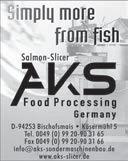
VredenburgSouthAfrica
Mobile: +27 83 2620362
E-mail: easycancc@gmail.com

Website: www.easycan.co.za

Polystyrene compressors

A/S
The specialist in fishbox compactors and recycling Tel. +45 97371799
runi@runi.dk www.runi.dk
Thermal conditioning
ONE OF THE MAIN MANUFACTURES OF PROCESSING MACHINES FOR BIG, SMALL AND VERY SMALL PELAGIC FISH


Nobbing down to 110 pcs/kg
Filleting down to 100 pcs/kg
Up to 450 fish pockets per min
Slånbärsv.4, SE-386 90 Öland Sweden
info@seac.se WWW. SEAC.SE
Slicers
A different
kettle of fish
Collect a free copy from the Eurofish stand, 5J600, at Seafood Expo Global in Barcelona
SALMCO Technik GmbH
Robert-Koch-Straße 19
D-22851 Hamburg-Norderstedt
Tel.: +49 40 7131472
Fax: +49 40 71370166
info@salmco.com
www.salmco.com
